Around 20% of small businesses fail during their first year, 45% fail during the first 5 years, and 65% fail during the first 10 years. Only 25% of new businesses make it to 15 years or more.
Impressive statistics that according to Investopedia, have not changed much over time and have been consistent since the 1990s.
Most businesses fail and the main reason for failure is that business owners do not know their role well. Most of them establish a business without a basic strategy, without a plan of action and without knowing the needs of the market nor their responsibilities as business leaders.
Certainly, some manage to do well without special knowledge and without experience, but at the first difficult moment and during periods of economic recession they give up.
Therefore, today I want to refer to the role of the contemporary business owner – and this role goes far beyond organising and managing businesses.
The modern business owner is primarily a top manager and a leader – a demanding, multidimensional and highly responsible role.
The role of a business leader is multi-faceted and crucial in driving the success and growth of an organization. Business leaders are responsible for making strategic decisions, setting goals, and guiding the overall direction of the company.
Let’s dive right in!
The Demanding Role of a Business Owner:
Leading Towards Success
Video Overview
Quick Navigation
- Challenges
- Statistics
- Common Reasons Why Businesses May Fail
- The Contemporary Business Owner/Leader
- Overview – Significance & Impact
- (Parenthesis)
- Organisation & Administration
- Vision & Strategy
- Decision-Making and Problem-Solving
- Team Building & Leadership
- Communication
- Innovation, Adaptation & Pioneering
- Customer Focus and Value-Driven Philosophy
- Financial Management
- Risk & Crisis Management
- Relationship Building
- Brand Reputation
- Performance Evaluation
- Quality
- Results
- Impact – Community – Movement
- Business Development and Growth
- Basic Knowledge & Education
- The 7ID Amalgam
- Epilogue
Challenges
Establishing, building, organising, and managing a successful business and leading an organisation in the most effective way is not an easy task and that’s especially true today. Business owners/leaders are called upon to face tremendous challenges such as fierce competition, unstable markets, and an ever-evolving business landscape in their journey.
Common Challenges Today
Competition: Rapid globalization and the rise of digital platforms have intensified competition, making it challenging to stand out.
Market Changes: Markets are evolving faster than ever, driven by technological advancements and shifting consumer preferences.
HQ Products/Services: Business owners are under pressure to develop unmatched, innovative, and HQ products and services that are in demand.
Customer Retention: Retention rates have been dropped dramatically lately. Customers are overwhelmed by the plethora of options and being loyal to a certain brand is becoming rare.
Talent Acquisition: Finding and retaining skilled employees is a persistent challenge in a competitive job market.
Technological Disruption: Keeping up with emerging technologies and adapting to digital transformation can be overwhelming.
Financial Pressures: Economic uncertainties, fluctuating markets, and access to funding can impact business stability.
Regulatory Compliance: Navigating complex and ever-changing regulations requires resources and expertise.
Supply Chain Disruptions: Global events can disrupt supply chains, affecting production and delivery.
Upfront Investments: tha majority of business models require upfront investments in capital, time, and resources, and there are emotional investments as well.
Building Authority: Building a name in any industry requires strong values, effective business and marketing strategies, and superior communications and service.
Challenges in Leadership Role
Decision-Making: Making critical decisions in uncertain environments requires a balance of data analysis and intuition.
Adaptability: Leaders must navigate change, pivot strategies, and remain agile in a dynamic business landscape.
Employee Engagement: Motivating and engaging a diverse workforce while fostering a positive company culture is a continuous effort.
Communication: Clear and effective communication with stakeholders, employees, and customers is essential but can be challenging.
Innovation: Driving innovation while managing risk involves fostering creativity and encouraging calculated experimentation.
Time Management: Juggling multiple responsibilities and priorities demands effective time management skills.
Strategic Thinking: Balancing short-term goals with long-term vision and strategy requires strategic thinking.
Crisis Management: Dealing with unexpected crises and disruptions demands quick decision-making and adaptability.
Work-Life Balance: Maintaining personal well-being while leading a business can be a constant challenge.
Business owners must navigate these challenges to lead their companies effectively, drive growth, and ensure the sustainability of their ventures.
Statistics
Beyond the negative statistics that I shared above, there are positive ones as well and we should take them very seriously.
For example, this one:
88% of millionaires in the US are self-made entrepreneurs. Interestingly, the majority of millionaires also went to college! This shows that having a basic knowledge is one of the keys for the success of a business.
Or this one:
The biggest motivation for entrepreneurs is being their own boss – what a wonderful cause. According to a report by Guidant Financial, 26% of respondents desired to be their own boss with a further 23% citing that they wanted to pursue their passions.
And here are a few more statistics that helps us shape a better opinion on the topic:
- There are 582 million entrepreneurs around the world
- 60% of people that start small businesses are aged between 40 and 60
- Germany, USA, and Japan are the best countries for entrepreneurs
- 59% of entrepreneurs apply for a loan so they can expand their business, while 43% use a loan to cover operating expenses.
- The internet is the most significant source of advice for entrepreneurs
- Approximately 65% of U.S. respondents believed that they possessed the requisite knowledge and skills for starting a business.
- The vast majority (97%) of current self-employed professionals have no desire to return to traditional work and most (70%) are actively working to grow their business.
- Small business proprietor’s incomes have increased by 15%
- 28% of small businesses have 1-5 employees
- 54% of small business owners say that communication is the most essential skill for success
- 12.3 million women own their own business in the US
- Middle-aged men are the most successful
- 71% of Generation Z (born in the late 1990s or the early 21st century) business-owning entrepreneurs are men
- Total employment by women-owned businesses rose by 21%
- There are 7 women entrepreneurs for every 10 male entrepreneurs starting a business
- Asian people are 51% more likely to be business owners
- 20% of women-owned businesses are owned by African-American women
- Entrepreneurs are world-class CEOs and financial managers. Studies highlight those entrepreneurs starting and running technology corporations generate 35% more ROIs than other companies in other industries.
- A comprehensive survey based on responses from hundreds of successful entrepreneurs revealed that 19% of those businessmen worked more than 60 hours a week, while only 5% work less than 30 hours a week.
- According to the US Small Business Administration (SBA) Office of Advocacy, there are 31.7 million small businesses in the U.S. in contrast to the number of large businesses which is only 20,139. Small businesses comprise 99.9% of all firms.
- A recent report by Shelton Group found that 86% of respondents believed companies should not only support social causes but also take a stance on social issues. On a related note, 64% of respondents stated that they believe companies should provide support for issues that align with the products or services they offer.
Conclusions:
- 1 of 5 small businesses fail during their first year but at the same time, 1 of 4 make it to 15 years or more (you get to decide which side you are on)
- There are business owners who manage to become successful and a big percentage of them become millionaires – those that have a basic knowledge are the majority
- There are certain countries where entrepreneurship flourishes
- Most business owners try to expand their business
- Most business owners do not return to traditional work
- There are women from all walks of life that become ultra successful entrepreneurs
- Asian people are into the game as well
- Entrepreneurs work really hard
- Small businesses make up the world’s economy
- Contemporary entrepreneurs take a stance on social issues and support social causes
- Small businesses that fail during the 1st year 20%
- Small businesses that fail during the first 5 years 45%
- Small businesses that fail during the first 10 years 65%
- Small businesses that make it to 15 years or more 25%
There are 582 Million entrepreneurs around the world
%
Small businesses represent the 99.9% of all businesses
Common Reasons Why Businesses May Fail
The failure of businesses can be attributed to various factors, and it’s often a combination of these elements rather than a single cause. Here are some common reasons why businesses may fail:
Lack of Market Demand:
Many businesses fail because they haven’t adequately assessed the market demand for their product or service. Understanding the needs and preferences of the target audience is crucial for success.
Poor Planning and Strategy:
Inadequate business planning and a lack of a clear strategy contribute to failure. Entrepreneurs need to have a well-thought-out business plan and a strategic vision to guide their decisions.
Financial Mismanagement:
Poor financial management, including issues like cash flow problems, overleveraging, and unsustainable spending, can lead to the downfall of a business.
Ineffective Leadership:
Leadership plays a critical role in the success of a business. Ineffective leadership, lack of experience, or poor decision-making by the management can lead to failure.
Failure to Adapt:
Markets, consumer behaviours, and technologies evolve. Businesses that fail to adapt to changes in the business environment may become obsolete or lose their competitive edge.
Insufficient Marketing and Sales:
Even with a great product or service, businesses can fail if they don’t effectively market and sell to their target audience. Marketing is essential for creating awareness and driving sales.
Competitive Pressure:
Fierce competition can be challenging for businesses. If a company is unable to differentiate itself from competitors or offer a unique value proposition, it may struggle to survive.
Operational Issues:
Problems in day-to-day operations, such as supply chain issues, poor quality control, or inefficient processes, can lead to customer dissatisfaction and business failure.
Legal and Regulatory Challenges:
Failure to comply with legal requirements and regulations can result in severe consequences for a business. Legal issues can range from compliance failures to lawsuits.
Unforeseen External Factors:
Economic downturns, natural disasters, global events (like the COVID-19 pandemic), and other external factors can significantly impact businesses, especially those with fragile structures.
Overreliance on a Single Customer or Supplier:
Dependence on a single customer or supplier can expose a business to significant risks. Losing a major customer or facing supply chain disruptions can be detrimental.
It’s important to note that entrepreneurship involves risk, and not all businesses succeed. Learning from failures and adapting strategies accordingly is crucial for aspiring entrepreneurs and established business owners alike.
The Contemporary Business Owner/Leader
The business owner is mainly the programmer, planner, coordinator, controller, organiser, manager, director, and administrator of the business.
With the latest evolution of concepts and perceptions, the basic functions of management have been expanded and the role of the business owner has been upgraded.
Now, a business owner is not just a top manager, in fact, is the heart and soul of the business.
In other words, is the leader of the business.
And no one can replace the business leader.
Overview – Significance & Impact
The role of a business owner has a high impact on different levels of society. As the statistics above show, small businesses shape the global economy – consider for a moment the weight of this statement.
There are businesses that hundreds of thousands of families or even entire countries rely on to survive – even small businesses or one-person businesses affect the social whole to an incredibly large extent.
This happens because, through businesses, the demand for the goods needed by consumers is met – that is, the entire population of the Earth, and for this to be possible, a series of entire industries will have to be set in motion.
When someone starts a business, at the same time they set in motion a tremendously large mechanism that creates the final products/services so that the social whole can satisfy its diverse needs, upgrade the standard of living, and progress.
Therefore, being a business owner presupposes seriousness, recognition on your part of the impact of your actions and decisions on society in general, moral values, a set of abilities – knowledge – skills, as well as a solid character, a balanced social life, and the fortitude to be able to cope with various adversities and difficulties.
The role of a business leader is multi-faceted and crucial in driving the success and growth of an organization. Business leaders are responsible for setting goals, making strategic decisions, assigning roles, and guiding the overall direction of the company. Their primary role involves:
- Organisation & Administration: The goal of business organization is to create a cohesive and streamlined structure that optimizes productivity, communication, and decision-making. It includes aspects such as organizing employees into functional units, defining reporting relationships, establishing workflows, and designing communication channels. Business management/administration involves planning, organizing, and coordinating the various activities and resources of a company to achieve its objectives. It encompasses a wide range of managerial functions, including setting goals, formulating strategies, making decisions, directing teams, and evaluating performance.
- Vision and Strategy: Business leaders define the vision (long-term goals, aspirations, and broader social impact) and mission (purpose) of the organization (reasons for existing). They set realistic and achievable goals and objectives and develop strategies and action plans to achieve those objectives, identifying key opportunities, markets, and competitive advantages. The business owner must balance short-term objectives with long-term strategic planning. An effective long-term strategy lays the foundation for sustainable growth and success.
- Decision Making & Problem-Solving: Leaders make critical decisions that impact the company’s performance, financial health, and market position that’s why they need to be analytical. They analyse data, market trends, and other relevant information to make informed choices. Problem-solving within the business context involves the systematic procedure of recognizing and addressing complications or obstacles that emerge during the execution of business activities and operations. Proficient problem-solving necessitates an organized method for pinpointing the issue, dissecting it, and formulating and executing a resolution strategy. In the symphony of business ownership, decisions compose the melody and problem-solving orchestrates the harmonies.
- Team Building and Leadership: A key role of business leaders is to build and lead skilled, motivated, and high-performing teams. They hire and develop talented individuals, delegate responsibilities, and foster a positive work culture. As the leader of the business, the owner provides guidance and direction to employees, inspiring them to work towards common objectives. Their leadership style influences the company culture and motivates the team to perform at their best. Effective team building and leadership create a productive work environment that enhances employee satisfaction and retention. Plus, successful leaders share some common skills and characteristics – see blog post common characteristics of successful entrepreneurs, plus go through the 7 IDEALS basic principles
- Communication: Effective leaders are strong communicators. They articulate the company’s vision and goals to employees, stakeholders, investors, and customers, ensuring everyone is aligned and motivated.
- Innovation, Adaptation, and Pioneering: In today’s dynamic market, innovation and adaptability are essential. The business owner must foster a culture of innovation, continuously seeking ways to improve products, services, and processes to stay competitive. Leaders drive innovation and encourage a culture of creativity and continuous improvement. They stay abreast of industry trends, embrace new technologies, and adapt the business model to meet changing market demands. Very often leaders become pioneers because they are willing to take risks – they disrupt established industries and ways of doing things to introduce new ideas or products and look for gaps in the marketplace where new opportunities exist for improving on current industry offerings.
- Customer Focus and Value-Driven Philosophy: Satisfied customers are the lifeblood of any successful business. The owner plays a crucial role in understanding customer needs, expectations, and feedback, ensuring the company abides by ethical business practices, follows the high standards of the business code of conduct, is authentic and transparent, delivers (and overdelivers) massive value to the market, and maintains strong customer relationships. That’s exactly the spirit inside the 7 IDEALS methodology – it’s a customer-centric and value-driven approach.
- Financial Management: Business owners bear the ultimate financial responsibility for the success of the venture and as leaders are responsible for financial oversight, including budgeting, resource allocation, and profitability. They ensure the company operates within its financial means and achieves financial targets.
- Risk & Crisis Management: Owning a business inherently involves risk. Leaders assess and mitigate risks that could impact the company’s operations, reputation, or financial stability, safeguarding the company’s interests and ensuring its long-term viability. They develop contingency plans to address potential challenges. Plus, leaders know their limits, they don’t just risk everything for something that might not return results that’s why they take calculated risks. Additionally, dealing with unexpected crises and disruptions demands quick decision-making and adaptability. The leader should be in a position to handle these unpleasant situations with confidence while having in mind the interests of their business and those involved in it.
- Relationship Building: Every touchpoint, every platform, every transaction, every contact, every discussion and interaction matters a lot. Strong business leaders build and maintain relationships with stakeholders, including customers, partners, suppliers, and investors. They also represent the company’s interests in external interactions with absolute confidence and elegant status.
- Brand Reputation: The actions and decisions of the business owner are affected by the dynamic environment in which their business operates and significantly impact the brand reputation. It’s all about our brand’s image, name, and authority in the marketplace. A positive reputation attracts customers, partners, and investors, while a negative one can lead to setbacks and loss of trust. The leader should constantly analyse the internal and external environment of their business and build the brand’s name.
- Performance Evaluation: Leaders monitor the company’s performance against key performance indicators (KPIs) and strategic goals. They implement necessary adjustments to stay on track. They also recognise and reward ambitious, dedicated, creative, innovative, and top-performing executives and staff members.
- Quality: Quality is the foundation of customer satisfaction, brand reputation, and long-term success. The leader has to deliver unmatched and HQ products/services but also ensure quality in all areas of the business beyond product development such as, customer service, market interactions, business processes and operations, employee training and development, compliance and regulation, supplier and vendor management, and more.
- Results: The business owner must bring results from every single activity and initiative undertaken by the business. This focus on results underscores the owner’s commitment to the company’s vision and mission and their dedication to delivering value to customers, employees, and stakeholders.
- Impact, Community, Movement: Successful businesses positively impact the communities they serve. Modern business owners have an opportunity to contribute to social causes, environmental sustainability, and community development beyond making money and maximising profits. In the 7 IDEALS methodology we take it one step further – we don’t just build communities but rather movements that allow people to unite in a shared interest, passion, or cause. When that happens, people do not identify themselves as customers of the brand, rather than loyal followers of a movement that has a leader – the brand.
- Business Development and Growth: The owner is responsible for deploying growth strategies. Growth or scaling strategies are focused on expanding a business beyond its current state, whether it be in terms of revenue, customer base, product line, or geographical reach through various means, such as opening new locations, expanding into new markets, or acquiring other businesses. It often involves careful analysis of market opportunities, investment in infrastructure and resources, and strategic partnerships, joint-ventures, or collaborations.
- Basic Knowledge & Education: the modern business leader should have at least a basic understanding of business organisation (and be ready for organisational change if needed), business management/administration (programming, planning, organising, managing, coordinating, monitoring, controlling, staffing, motivating, rewarding, being creative, innovative, MIS, and more), their business model and operations, marketing (it includes market research, branding, advertising, sales, customer service, events, and more), product development, economics, accounting, mathematics, statistics, business law and regulations, human psychology, consumer behaviour (a necessary key to developing a unique marketing strategy and getting people to respond positively to their communications), sociology and industrial sociology, technology, computers, software, and digital tools, general encyclopedic education, and industry-specific knowledge – that’s why I created a special coaching program for the 7 IDEALS methodology – specifically designed for business leaders that want to innovate and pioneer).
- The 7ID Amalgam: this a concept that I will discuss during the presentation of the 7 IDEALS methodology.
Overall, a business leader plays a crucial role in inspiring and guiding the organization towards success, fostering innovation, and creating a strong company culture that attracts top talent and encourages loyalty among employees and customers alike.
The business owner is the machine of the business, the eyes that see and monitor everything and keep everyone involved in alignment with the other members of their organisation.
The leader leads by example, sets high-quality standards and is responsible for the direction and image of the business.
The role of the business owner is of paramount significance and has a profound impact on the success of the business.
In summary, the role of the business owner extends far beyond business organisation & adminsistration and financial investment; it entails leadership, vision, and the ability to navigate challenges while driving the business towards success. Their decisions, actions, and values influence the entire organization, shaping its culture, reputation, and long-term prosperity. The business owner’s dedication and effectiveness in their position play a pivotal role in determining the business’s success and impact on society at large.
(Parenthesis)
I mentioned my methodology in the previous section, so let me briefly introduce myself.
I’m Tasos, founder of the agency WebMarketSupport and creator of the “7 IDEALS” methodology.
I have a Business Organisation & Administration degree (University of Macedonia Hellas) and I have been a traditional entrepreneur since 1992. I expanded my business online in late 2014 and from that time, I’ve helped hundreds of brands sell more of their products and services as a marketing consultant.
7 IDEALS MOTTO:
- INNOVATION
- QUALITY
- RESULTS
- IMPACT
- GROWTH
As you can see, the role of contemporary business owner/leader includes these attributes.
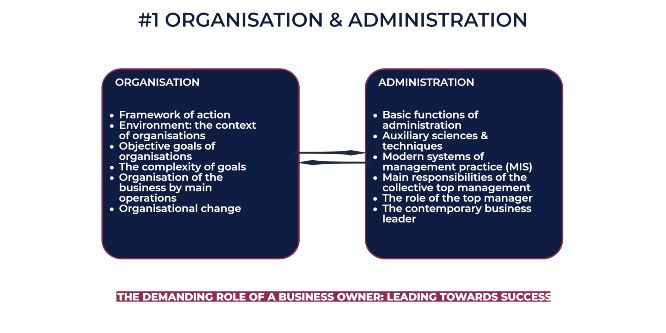
#1 Organisation & Administration
The Framework of Action
The entrepreneur, as the leader of the business, must possess comprehensive knowledge and proficiency in organizing, managing, and administering all aspects of the organization, exercising omniscience, providing direction, coordination, and motivation while serving as a representative of the business.
Environment: The Context of Organisations
The environment in which businesses operate is constantly and rapidly changing. The factors that dominate this environment can be classified into the following categories:
- Environmental effects (trends)
- Social responsibility
- Administrative ethics
External:
- Economic
- Technological
- Social and cultural
- Political and legal
- Environmental
- Global
- Customers
- Suppliers
- Competitors
- Intermediaries
- Public
- Stakeholders
Internal:
- Organisational culture
- Organisational structure
- Leadership and management
- Employees
- Internal processes
- Resources
- Technology
- Internal communications
- Policies and procedures
- Organisational goals and strategies
Objective Goals of Organisations
Organizations are purposefully created to fulfill specific needs, known as objective goals, representing the desired outcomes, and the effectiveness of an organization is determined by the extent to which these goals are achieved, a process requiring careful consideration by top management given the intricate interplay of external and internal forces influencing business goals beyond mere profit.
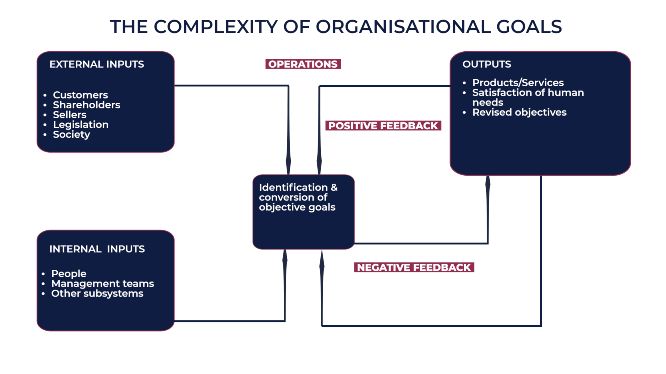
Determination of the Objectives
I. Aspirational Variables:
- Profit
- Social responsibility
- Personal goals
- Government objectives
- Workers’ unions
ΙI. Objective Goals:
- Economic objectives
- Customer satisfaction
- Creating results
- Improvement/development of employees
- Social performance and administrative ethics
Usefulness of Objectives
Objectives help:
- in making decisions
- in the utilization of the opportunities presented
- in personal motivation
- in the creation of standards
Basic Functions of Administration
The administrative officer’s actions are referred to as management elements, summarized as follows:
- programming/planning
- organization
- management/administration
- control
- staffing
- motivation and incentives
- creativity
- innovation
- productivity
- management information system (MIS)
- optimization of audit/controlling procedures
Programming/Planning
Planning involves defining objectives and determining the means to achieve them, necessitating decision-making through the selection of alternative solutions and courses of action within specified policy limits, culminating in a rational thinking process that includes problem analysis, exploration of alternatives, and implementation of the chosen decision.
Organisation
Once the executive establishes objectives, they must devise a structure for optimal task execution, starting with the analysis and division of work, the creation of corresponding positions, and assignment of specific tasks; however, the organizational structure is not an end in itself but a means to achieve company objectives, emphasizing the importance of utilization and specifying power relations, responsibilities, and accountability.
Organisation of the Business by Main Operations
Business operations are categorized based on the relevance of actions, with each function assigned to a corresponding organizational body within the structural distribution of activities. These bodies, represented by specific individuals, are further differentiated into broad and partial functions.
In the 7 IDEALS methodology, designed for small and medium-sized businesses, operations are classified in a way that enhances flexibility, efficiency, and effectiveness, enabling businesses to adapt methodically to changes.
This model not only ensures survival in competitive environments but also empowers businesses to pioneer and innovate. The specific distribution of functions in this model transforms the General Manager into a fully equipped Leader, setting an example for executive bodies and other team members.
BUSINESS OPERATIONS:
- Organisation – Administration – Management
- Marketing
- Production & Supply Chain
- Financial Management/Economics
- Human Resources
- Information Technology & Web Development
- Legal and Regulatory Compliance
- Social Image & Responsibility
- Innovation
- Business Development
I analyze the organization of businesses into main opeartions/functions thoroughly throughout the 7 IDEALS methodology 2nd phase – “Big Ideas” where we formulate our overall business strategy
Management/Administration
Management, an integral part of administration, involves directing and motivating subordinates to achieve defined goals by creating an environment where individuals can fulfill organizational objectives.
Effective communication, participation in goal-setting, and the supervisor’s behaviour and motivational skills play crucial roles in fostering such a climate.
Collaboration with formal groups like committees is essential, but the emergence of informal groups, such as horizontal, vertical, and mixed cliques, also significantly impacts the work environment.
Recognizing and understanding the role of informal groups, known as cliques, is vital for the administrative staff to address potential conflicts and manage these groups appropriately, ensuring alignment with the organization’s goals.
Control
Control in administration assesses performance against goals, identifies weaknesses, and implements corrective measures for optimal results, serving as a dynamic coordination tool to monitor progress and make proactive adjustments as needed.
Staffing
Staffing is a key focus in contemporary management, involving the selection of executives across various levels, from top management (chief executives) to senior management (managers of main business sections), middle managers (e.g., deputy directors), and lower administrative officers overseeing specific subsections.
Motivation – Incentives
Motivation is a universal duty for administration, extending beyond material rewards to encompass good relations, favorable work conditions, and employee participation in decision-making. It involves compliance with legislation, satisfaction from work, an expectation of personal involvement in the enterprise’s success, and a perception of equalized roles and power between employees and managers.
Creativity
Innovation
Productivity
Management Information System (MIS)
Optimization of Audit/Controlling Procedures
Organisational Change
Organizations, in constant interaction with their environment, undergo organizational change to adapt. Managers must distinguish between planned and unplanned changes. Unplanned changes occur randomly, like strikes or disputes, while planned changes strategically address performance gaps, ensuring vitality. These changes encompass technology, products, administration, and worker attitudes. Organizations, as open systems, need internal mechanisms for planned changes to thrive in a dynamic business environment.
Any type of organizational change is likely to cause chain reactions. The figure below clearly shows these interactions:
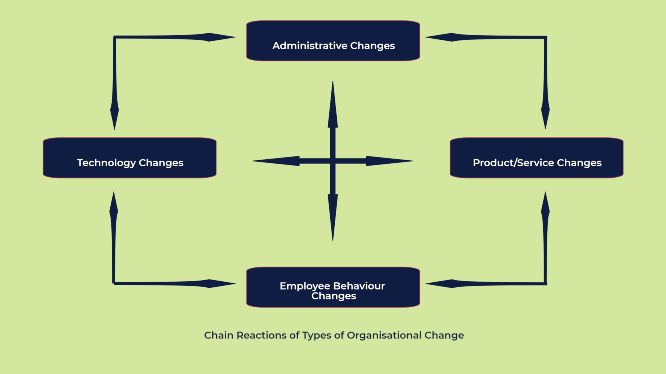
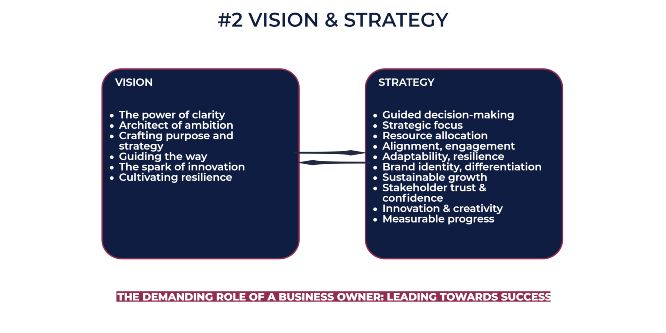
#2 Vision & Strategy
In the dynamic realm of business, a clear vision acts as a guiding beacon, illuminating the path toward success. At the helm of every thriving enterprise stands the business owner, fulfilling the role of the visionary leader.
The leader defines the vision – long-term goals and aspirations; is the big plan for the company, where they want to see their company in the future. The leader also defines the mission – the purpose of the organisation; why they do what they do.
Here are the reasons why a well-defined business vision plays a central role in shaping the company’s destiny:
The Power of Clarity: A crystal-clear vision serves as the bedrock upon which a business is built. It encapsulates the core values, aspirations, and objectives of the company. The visionary leader’s ability to articulate this vision becomes a driving force, aligning teams, and fostering a shared sense of purpose.
Architect of Ambition: As the steward of the business, the owner assumes the mantle of the visionary leader, intricately weaving dreams into actionable goals. Through innovative foresight, they carve out a roadmap that navigates challenges and harnesses opportunities, ensuring the business’s sustained growth.
Crafting Purpose and Strategy: Beyond profit margins, a visionary leader infuses the business with purpose. This purpose, deeply intertwined with a long-term strategy, fuels the organization’s identity and sets it apart in a competitive landscape. It inspires teams, resonates with customers, and shapes the brand’s narrative.
Guiding the Way: The visionary leader not only conceives the vision but also steers the course toward its realization. By instilling a sense of direction, the owner paints a vivid picture of the future, allowing teams to channel their efforts toward a common goal and inspiring unwavering dedication.
The Spark of Innovation: Vision and innovation are inseparable companions on the journey to success. A visionary leader possesses the acumen to envision groundbreaking solutions, leading the charge in adapting to changing markets, technological advances, and evolving customer needs.
Cultivating Resilience: Amid the tumultuous currents of business, a strong sense of purpose and direction serves as an anchor of resilience. The business owner, as the visionary leader, imparts the unwavering determination to weather storms and overcome obstacles, nurturing an environment where challenges become opportunities.
The visionary leader holds the compass, charting the course, and inspiring the crew. With a clear vision as their guiding star, they mold the company’s destiny, drive innovation, and cultivate a culture of purpose-driven achievement.
The strategy is the plan that the business leader is deploying for achieving the organisation’s objectives.
Strategies are used in various fields, such as business, military, sports, and politics, to name a few.
They involve analysing a situation, identifying opportunities and challenges, and developing a plan of action to achieve the desired outcome.
A successful strategy involves clear goals, a thorough understanding of the environment, effective decision-making, and the ability to adapt to changing circumstances.
In the context of business, a strategy outlines how we will operate and manage the business, compete in the market, create value for our customers, employees, executives, stakeholders, partners, our business itself, the state amd its various services, the natural environment, and society at large, plan for the future, and ultimately achieve long-term success.
A strong sense of purpose and a well-defined long-term strategy are the cornerstone of a successful and enduring business. These elements provide a clear direction and framework that guide the business owner and the entire organization, offering a multitude of benefits that contribute to sustained growth, resilience, and meaningful impact:
Guided Decision-Making: A defined purpose and long-term strategy serve as a compass for decision-making. They help business owners and teams evaluate options and choose paths that align with the overarching vision, minimizing distractions and ensuring that every choice supports the ultimate goals.
Strategic Focus: A clear sense of purpose keeps the business focused on its core mission, preventing it from getting sidetracked by short-term trends or distractions. Long-term strategy provides a roadmap to achieve that purpose, outlining the steps required for success.
Resource Allocation: Purpose and strategy aid in efficient resource allocation. By understanding where the business is headed and what it stands for, resources can be directed toward initiatives that have the most significant impact on achieving long-term goals.
Alignment and Engagement: A strong sense of purpose rallies employees around a common cause, fostering a sense of unity and shared values. A well-communicated long-term strategy provides clarity and direction, enhancing employee engagement as they understand their role in the bigger picture.
Adaptability and Resilience: A long-term strategy encourages businesses to anticipate changes and challenges in the market. This proactive approach enhances the ability to adapt and respond effectively, ensuring the business remains resilient in the face of uncertainties.
Brand Identity and Differentiation: Purpose-driven businesses often have a distinct brand identity that resonates with customers on a deeper level. A long-term strategy supports consistent branding and differentiation, helping the business stand out in a competitive landscape.
Sustainable Growth: Purpose and strategy foster sustainable growth by preventing short-term decisions that could undermine long-term success. They encourage deliberate, well-calculated actions that build a solid foundation for the business’s expansion.
Stakeholder Trust and Confidence: A clear sense of purpose and a transparent long-term strategy instill trust and confidence in stakeholders, including customers, investors, partners, and employees. These stakeholders are more likely to engage with and support a business that has a compelling vision and a plan to achieve it.
Innovation and Creativity: A long-term strategy provides a framework for innovation and creativity. It encourages the exploration of new ideas and solutions that align with the business’s purpose and long-term goals.
Measurable Progress: Purpose and strategy allow for the measurement of progress and success. By setting specific milestones and objectives, businesses can track their advancements and make informed adjustments to ensure they stay on course.
In summary, a strong sense of purpose and a thoughtfully crafted long-term strategy are essential ingredients for a business’s sustained success. They provide direction, focus, and a framework for growth, ensuring that every effort contributes to the realization of the business’s mission and vision.
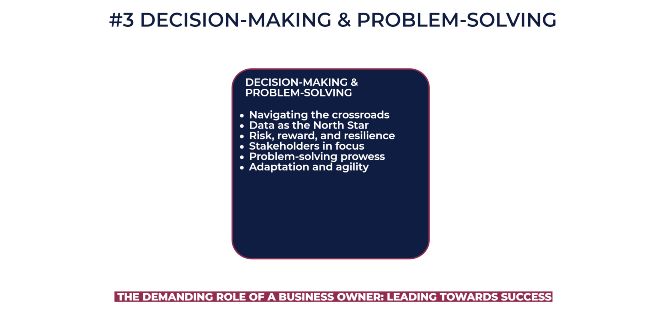
#3 Decision-Making & Problem-Solving
The art of decision-making and the skill of problem-solving form the basis for success. The dynamic realm of a business owner’s decision-making process, their astute analysis of data, calculated risk assessment, and the profound influence these choices bear on the business and its stakeholders is obvious:
Navigating the Crossroads: At the heart of every pivotal juncture lies the decisive mind of a business owner. The decision-making process is multifaceted, and the owner must meticulously weigh options, consider potential outcomes, and ultimately set the course for the company’s trajectory.
Data as the North Star: Data is the compass that guides strategic choices. There is a strong correlation between data analysis and decision-making. The business owner’s adeptness in interpreting market trends, consumer behavior, and financial insights empowers them to make informed, data-driven decisions that steer the business toward prosperity.
Risk, Reward, and Resilience: Every decision carries a shadow of risk, but it is the business owner’s acumen that transforms risk into opportunity. The leader must balance between risk and reward, as they navigate uncharted waters with calculated courage, embracing challenges as stepping stones to growth.
Stakeholders in Focus: The choices made by a business owner ripple far beyond the confines of their office. The impact of their decisions on various stakeholders – employees, customers, partners, and the broader community is profound. The business owner’s responsibility extends beyond profit, encompassing ethical considerations and societal well-being.
Problem-Solving Prowess: Challenges happen for a reason. The business owner’s role is primarily solving problems in the most effective way. Armed with creativity, adaptability, and a tenacious spirit, they navigate the labyrinth of obstacles, transforming hurdles into milestones and setbacks into triumphs.
Adaptation and Agility: The business landscape is a dynamic tapestry of change, demanding agility and quick thinking. The owner’s ability to pivot and adapt, embracing market shifts and technological disruptions with innovative problem-solving, ensures that the business remains at the vanguard of progress.
The choices made by the business owner not only shape the destiny of their enterprise but reverberate throughout the industry and beyond.
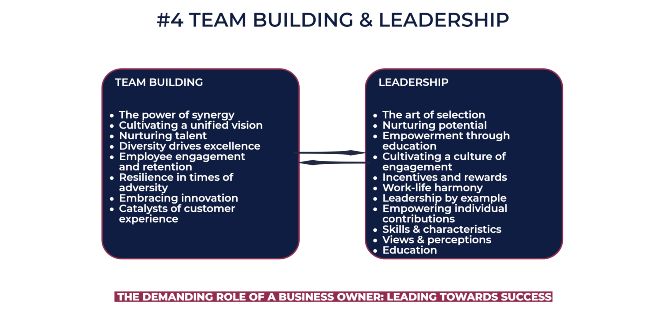
#4 Team Building and Leadership
Businesses cannot grow much without the help of other members beyond the business owner.
Building a strong team is the cornerstone of business success.
In the ever-evolving landscape of business, the foundation of success lies not just in visionary leadership and strategic prowess, but equally in the strength of the collective – the team that propels the enterprise forward.
And here is why building a robust and cohesive team has a profound significance:
The Power of Synergy: A harmonious team is more than the sum of its parts; it is a collection of diverse talents working in unison. Leading a dynamic team, where each member’s unique strengths bolster the collective’s capabilities, is an extremely competitive advantage.
Cultivating a Unified Vision: Behind every triumphant business, there stands a team united by a shared vision. The role of the business owner is to foster a common purpose, align each team member’s aspirations with the larger goals of the enterprise. The result is a force propelled by a collective passion for success.
Nurturing Talent: A strong team is nurtured by the cultivation of individual potential. The business owner’s role is that of a mentor and guide, invested in the professional growth and skill development of their team members. The investment in education and training fuels both personal advancement and the company’s overall prosperity.
Diversity Drives Excellence: Diversity within a team is not merely a buzzword; it is a catalyst for innovation. Diverse backgrounds, perspectives, and experiences play a central role in sparking creativity, problem-solving, and ingenuity, ultimately steering the business toward unrivaled excellence.
Employee Engagement and Retention: Beyond recruitment lies the ongoing journey of engagement and retention. The business owner keeps their team motivated, satisfied, and committed – from fostering a positive work culture to recognizing and rewarding achievements, each action serves to fortify the bonds within the team.
Resilience in Times of Adversity: In the face of challenges, a resilient team is a pillar of strength. Human resources are significantly important in nurturing a culture of adaptability and collective resilience. A team that stands together, undeterred by obstacles, can weather storms and emerge stronger on the other side.
Embracing Innovation: An empowered team fuels innovation, propelling the business into uncharted territories. The business owner fosters an environment that encourages experimentation, risk-taking, and the free flow of ideas – elements that produce groundbreaking solutions and elevate the enterprise to new heights.
Catalysts of Customer Experience: The impact of the team reverberates outward, shaping the customer experience at every touchpoint. The team delivers exceptional service, fosters client relationships, and infuses the brand with authenticity and humanity.
A business leader is not someone who orders for tasks to be executed and completed. Is not someone who is demanding things all the time and definitely, is not a dictator.
Insted, the leader is leading the example.
Is the one who shows how work is being conducted and is a hard worker.
The leader of an organisation is being followed by other people because of their passion, vision, values, ethics, and principles.
The business owner’s triad of recruitment, training, and motivation:
The Art of Selection: The alignment between a candidate’s aspirations and the company’s vision sets the stage for a dynamic partnership.
Nurturing Potential: Transforming raw talent into a force of competence requires meticulous training. The business owner’s is responsible for designing effective training programs that equip employees with the skills, knowledge, and tools needed to thrive.
Empowerment through Education: A business owner is not just a leader; they are an educator, imparting wisdom that fuels innovation and progress. The business owner’s role is to provide ongoing learning opportunities, from workshops to online courses, foster an environment that champions continuous improvement and intellectual enrichment.
Cultivating a Culture of Engagement: Motivated employees are the lifeblood of a thriving business. The business owner cultivates a culture of engagement and fosters open communication to recognizing and celebrating achievements.
Incentives and Rewards: The business owner is a motivator, crafting incentives and rewards that inspire exceptional performance. Recognition, promotions, bonuses – each gesture reinforces the value the business places on its team’s contributions and guides employees to excel.
Fostering Work-Life Harmony: A harmonious work-life balance is more than a perk; it’s an essential ingredient in employee satisfaction. The business owner’s role is to implement flexible work arrangements, wellness programs, and initiatives that prioritize employees’ holistic well-being.
Leadership by Example: The business owner is not a distant figurehead but a hands-on leader, setting an example through their actions and dedication. The owner’s commitment, work ethic, and empathy resonate throughout the organization, igniting a sense of camaraderie and shared purpose.
Empowering Individual Contributions: The business owner’s role is to empower individuals to make meaningful contributions. By providing autonomy, encouraging innovation, and valuing diverse perspectives, the owner nurtures an environment where every voice is heard and every idea matters.
Leaders always strive for excellence – there is always room for improvement and that’s especially true in the entrepreneurial world.
Entrepreneurship is not just running businesses.
Entrepreneurs/leaders have a vision and dreams, and they are obsessed with their mission.
And as I mentioned above, successful entrepreneurs share some common skills and traits/characteristics:
- Organisational/Administrative
- Risk takers (being courageous)
- Creative
- Innovators
- Action-takers/highly-motivated
- Decision-makers
- Problem solvers
- Productive
- Responsible
- Disciplined
- Good listeners
- Leaders
- Open-minded
- Curious
- Learners
- Practitioners
- Excel in communications
- Relationship builders
- Collaborative
- Supportive
- Rewarding
- Self-confident
- Self-critical and self-aware
- Persuasive
- Enjoy private time
- Customer-focused
- Impact & value driven
- Community/movement builders
- Ensuring quality
- Ethical business practices
- Result-driven
- Experts in financial management
- Risk & crisis management skills
- Critical thinkers, analytical
- Visionaries
- Strategists
- Development & growth focused
- and have basic knowledge and education
Views & Perceptions on Leadership
The leader of the enterprise, according to older perceptions was the entrepreneur, while according to the contemporary perceptions, he is a professional, with special training and innate abilities.
In the past, the characteristics of the business owner (entrepreneur – individual or shareholder) and the leader of the business coincided. Today, the ownership (of the largest mainly companies) is dispersed among many shareholders, who cannot obtain a majority (and therefore the control and management of the company) and the leadership of the companies is taken over by “career” persons, professional managers.
W. Sombart’s views
The great sociologist and economic historian mentioned the following abilities of the economic leader:
- psychological skills (courage, determination, patience, persistence, initiative, consistency of thought and action)
- organizational skills (harmonization of material resources and human resources)
- administrative skills (selection, direction and supervision of staff, creating a spirit of trust, cooperation and commitment to duty)
- commercial skills (ability of financial calculation, i.e. direct perception and valuation in money of every activity, event or result and ability to conduct discussions without losing the initiative)
- other abilities (manifest ability of will and spirit, intense vitality and great power of action, alienation from religious entanglement, enjoyable comfort and artistic romanticism)
L.P. Alford’s opinions
The American engineer Alford, who formulated administrative laws, as the first law mentions that of leadership with the following words: “Sober leadership is more necessary than extensive organization or perfect mechanical equipment” and “Sober politics is worth more than a big factory, good management and perfect machinery”. The most essential characteristics of a real leader are:
- the creative ability
- the wide range of perceptions
- courage
- honesty
- the independence
- philoponia (willingness to work)
H. Fayol’s views
The French engineer Fayol, who is considered the founder of scientific management, defined the following qualities of the business leader:
- physical health and physical prosperity
- intelligence, perception and moral fortitude
- moral qualities (energy, honesty, persistence, stability of character, directness, initiatives, dedication, etc.)
- general (encyclopedic) education
- administrative knowledge (knowledge of administrative duties)
- knowledge of the role and content of all functions and sections of the enterprise
- special professional knowledge (experience) related to the operation of the enterprise.
In addition to the qualifications of the leader, Fayol expressed the opinion that the leader in charge of management should:
- have deep knowledge of his personnel
- remove the incompetent
- be familiar with the contracts between the company and the employees
- set a good example
- make periodic inspections of the social body (personnel)
- gather his main collaborators in meetings, in which the unity of management and the common course of efforts are prepared
- not let the details absorb him
- strive, to prevail in his personnel, initiative and dedication
Fr. Baumgarten’s views
The psychologist-sociologist Baumgarten lists a long table of the characteristics of the business leader, which are related to the psychological sphere:
- to have a positive perception of life
- to possess human psychology
- to handle the written and spoken language
- to be perceptive
- to have a stable and balanced character
- to know how to consider the opinions of others without prejudice
- to have sufficient knowledge to judge a situation and make the necessary decisions
- to judge the work of others fairly
- to be able to gain the trust of others
- to be honest
- have integrity
- to be lenient
- his words and actions have a continuity
- to be modestly ambitious, but not vain
- to be useful
- to have personality
- to set an example for imitation
- to know how to direct people
- to be demanding of himself
- to be able to use the experience gained
- to be helpful
- to have self-discipline
- to be active
- to have gentle manners
- to believe in the intended purpose
- to be self-confident and take initiatives
- not be afraid of responsibilities and dangers/risks
- to know how to impose
- to be straight
- not to be meticulous
- to support the legitimate requests of the staff
etc.
P. Drucker’s views
The opinions of the Austrian-born, management professor at the New York University Graduate School of Business, Peter Drucker, who dealt with management and managers as much as noone else, have a special weight. The manager must:
- be able to manage the business with the new requirements
- assume risks for a longer period of time
- be able to make “strategic decisions”
- be able to form a complete team
- be able to transmit information quickly and clearly
- see the business as a whole and allocate its functions appropriately
- combine production with the pursuit of conquering a wider market
The manager’s job is to:
- set objective goals
- organize
- prompt and communicate
- measure (analyze, determine and interpret) performances
- develop people, including himself
Every manager needs basic training to acquire these essential managerial “skills”
Views on the Training of Managers
Undoubtedly, certain innate abilities (character, personality) are required for managers. However, their training, qualification and education is necessary.
According to Basil, business leaders must be equipped with intellectual qualifications, with appropriate knowledge, have culture that increases their activity and improve their behavior, be civilised and also have some useful practical knowledge.
Gerbier and Almard state that the training and education of business leaders should include: technological knowledge related to industry or commerce, management techniques, administrative techniques, forecasting techniques and applied psychology.
In senior leadership positions there may be specialization, but in top management positions specialization should be rejected. This is why the training of leaders is very broad.
Deverell states that an administrative training program aims:
- to give existing managers the opportunity to develop their skills
- to choose executives for administrative succession
- to open the way for promotion to staff members who show promise of development
- to encourage leaders to utilize the abilities of their assistants
- to raise the level of administrative performance
Various teaching methods are used for this purpose, in full-time or part-time training, and mainly, the discussion group system, the case study method, business games, the use of computers, etc.
The Synchronous/Modern Leader/Manager (opinions – responsibilities – environment – properties)
Contemporary Views
- the route-destination view (path – goal theory). This refers to the close connection that must have between the course followed by the manager and the goal or goals he is pursuing (R. House & T. Mitchell 1975)
- the vertical dual linkage model. This opinion, formed by University of Cincinnati professor George Graen and his colleagues, considers that the problem of the leader-manager is not exclusively, personal – his, but also of his subordinates, who have their own choices. It is therefore necessary to link (close, unbreakable connection) these two parts (dual) in order for the exercise of management to be effective
The Manager’s Social Responsibility
The leading authors Koontz, O’Donnell and Weihrich consider that today’s manager has a responsibility not only towards the business, but also a more general, social responsibility, towards the state, higher schools, non-profit organizations and the social whole (which exercises the “social control’ over him).
In the context of his social responsibility, he must harmonize his actions with his (political, economic, religious, moral, social) environment, solve human and social problems, take care of the production and distribution of goods that the social whole needs and to defend the environment in all its forms (natural, social, cultural, educational, legislative, economic, ecological).
Thus, the role of the modern manager acquires particularly great social significance.
Synchronous Management Requirements from the Manager
Management has a dynamic nature. It is constantly evolving. The new market and environment conditions create more and greater demands from managers.
Management has already become multidimensional.
It accepts the effects of the ever-evolving and changing environment.
External factors multiply and become more imperative.
Advances in the social, cultural, educational and above all in the technological field create new situations.
Within the business, the educational and cultural level of the workers has risen a lot and imperatively puts forward their request for participation in the management and the results.
Consumption is constantly changing.
With the improvement of the economic and cultural level, new needs arise and new demands are put forward.
Furthermore, the development of modern ecological concepts that want the business to be an ally and not an adversary in the protection and improvement of environmental conditions, adds new obligations to managers.
All the things that I mentioned – and much more – shape the new framework of the demands that the practice of management has on today’s managers.
The Education of Contemporary Managers
In order for the manager to respond to the many, extra-business and intra-business, requirements, he must have certain physical abilities and skills, but he must also acquire extra specific skills, i.e. certain knowledge (education).
Today we believe that this knowledge should come from the following fields of science and technology:
- of economics (basic economic knowledge)
- theory and practice of business organization and management/administration
- financial accounting
- business law (legislative)
- of higher mathematics and statistics (for the application of the latest mathematical and statistical techniques)
- psychology (individual and group)
- of sociology (to assess the interactions and interdependence of human groups)
- computer technology (for the personal use of simple computers and especially microcomputers)
Private Coaching Program
That’s exactly the content inside the private coaching program that I provide in my methodology – 7 IDEALS – in the #1 phase – 7ID ZONE. An extra training layer exclusively designed for business leaders.
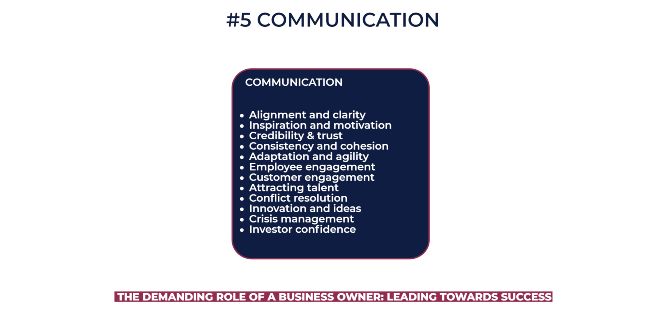
#5 Communication
Being a strong communicator who effectively articulates the company’s vision and goals is a pivotal role for a business leader. This skill has far-reaching benefits that positively impact various aspects of the business and its relationships:
Alignment and Clarity: Effective communication ensures that everyone, from employees to stakeholders, understands the company’s purpose, direction, and objectives. This alignment creates a shared sense of purpose, which boosts collaboration and minimizes misunderstandings.
Inspiration and Motivation: A leader who communicates the company’s vision and goals passionately can inspire and motivate employees. When employees connect with the larger purpose and see the impact of their work, they become more engaged and enthusiastic about their roles.
Credibility and Trust: Clear communication builds credibility and trust. When a leader consistently communicates transparently and honestly, stakeholders—such as investors, partners, and customers—develop confidence in the business’s integrity and direction.
Consistency and Cohesion: Communication helps ensure that everyone is on the same page and that there is consistency in messaging across the organization. This cohesion strengthens the brand and prevents confusion in the market.
Adaptation and Agility: Effective communication enables the leader to convey changes in strategy or market dynamics swiftly and clearly. This allows the company to adapt and pivot with agility when necessary.
Employee Engagement: Regular communication from the leader fosters a sense of belonging and engagement among employees. It makes them feel valued and informed, enhancing their commitment to the company’s success.
Customer Engagement: Communicating the company’s vision and values to customers creates an emotional connection. This connection can lead to stronger customer loyalty, repeat business, and positive word-of-mouth referrals.
Attracting Talent: A leader who articulates a compelling vision and clear goals can attract top talent who want to be part of an inspiring and purpose-driven organization.
Conflict Resolution: Effective communication can help resolve conflicts by providing a platform for open dialogue and understanding. A leader who encourages communication can address issues before they escalate.
Innovation and Ideas: An open and communicative environment encourages employees to share their ideas and innovative solutions. This can lead to continuous improvement and creativity within the company.
Crisis Management: During challenging times, a leader’s strong communication skills are crucial for providing reassurance, direction, and solutions. Clear communication can help manage crises more effectively.
Investor Confidence: Articulating the company’s vision and goals effectively can boost investor confidence. Investors want to know where the company is headed and how their investments will contribute to its success.
In essence, a business leader’s ability to communicate the company’s vision and goals is a cornerstone of effective leadership. It shapes the company’s culture, influences stakeholders, and plays a pivotal role in driving the business forward toward its intended destination.
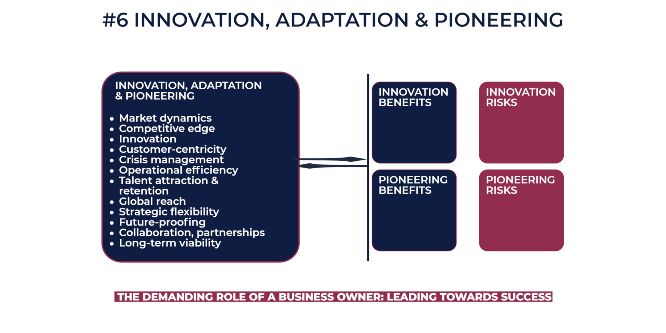
#6 Innovation, Adaptation, and Pioneering
In today’s rapidly changing business landscape, adaptability and agility have become essential attributes for a successful business. Here’s a brief overview of their importance:
Market Dynamics: Markets are in a constant state of flux due to technological advancements, consumer preferences, and competitive pressures. Businesses that can quickly adapt to these changes can seize opportunities and stay ahead of the curve.
Competitive Edge: Agile businesses can swiftly respond to competitive threats and emerging trends. This flexibility allows them to outmanoeuvre competitors, capture market share, and maintain a competitive edge.
Innovation: Adaptability fosters a culture of innovation. Businesses that can pivot and embrace new ideas are more likely to develop groundbreaking products, services, and business models that cater to evolving customer needs.
Customer-Centricity: The ability to adapt means aligning products and services with changing customer demands. This customer-centric approach enhances customer satisfaction, loyalty, and retention.
Crisis Management: In times of crisis, such as economic downturns or unexpected events, agile businesses can quickly adjust their operations and strategies to mitigate risks and ensure business continuity.
Operational Efficiency: Adaptability streamlines processes and eliminates inefficiencies. Agile organizations continuously refine their operations to enhance productivity and reduce costs.
Talent Attraction and Retention: A culture of adaptability appeals to top talent seeking dynamic and innovative workplaces. Businesses that foster agility are more likely to attract and retain skilled employees.
Global Reach: In a globalized world, businesses often face diverse markets, regulations, and cultures. An adaptable approach allows for the customization of strategies to suit different markets.
Strategic Flexibility: Agile businesses can shift strategies based on real-time feedback and data. This flexibility ensures that goals and tactics remain aligned with the evolving business landscape.
Future-Proofing: An adaptable mindset prepares businesses to anticipate and respond to future challenges. By embracing change, businesses are better positioned to withstand disruptions and capitalize on emerging opportunities.
Collaboration and Partnerships: Agile businesses can easily form partnerships, collaborations, and joint ventures to leverage expertise, expand reach, and access new markets.
Long-Term Viability: Adaptability contributes to a business’s long-term viability and sustainability. Businesses that resist change risk becoming obsolete in an evolving marketplace.
In summary, adaptability and agility empower businesses to navigate the ever-changing terrain of the business world. They enable rapid responses to shifts in markets, technology, and customer preferences, ensuring that the business remains resilient, innovative, and well-positioned for success.
Now, innovation and pioneering is not for every business owner. Both approaches are risky and no one can predict the future with absolute confidence.
The market might not respond positively to innovative and pioneering solutions even when there is hard evidence and research that backs up those solutions.
That’s why I give you both the benefits and the risks of these approaches below so you can decide on your own.
For me, the benefits far exceed the risks associated with innovation and pioneering.
Innovation is my main drive as an entrepreneur and my methodology is designed exactly for helping small businesses to innovate and pioneer.
Benefits of an Innovation Culture
Competitive Advantage: An innovation culture fosters the development of unique products, services, and solutions that differentiate a company from its competitors, creating a competitive edge in the market.
Market Leadership: By consistently introducing innovative offerings, a company can become a market leader, setting trends and influencing industry standards.
Customer Satisfaction: Innovation-driven products and services address evolving customer needs, leading to higher customer satisfaction, loyalty, and long-term relationships.
Employee Engagement: A culture of innovation engages employees in problem-solving and creative thinking, boosting morale, job satisfaction, and retention.
Adaptability: An innovative organization is better equipped to adapt to changing market dynamics and capitalize on emerging opportunities.
Efficiency and Productivity: Innovation often leads to process improvements and automation, enhancing operational efficiency and productivity.
Resilience: A culture of innovation encourages experimentation and risk-taking, making the organization more resilient in facing challenges.
Risks of an Innovation Culture
Resource Allocation: Innovation initiatives may require significant resources, potentially diverting funds and attention from existing core business operations.
Failure and Risk: Not all innovative ideas succeed. Organizations must be prepared for failure and the associated financial and resource risks.
Resistance to Change: Employees accustomed to traditional methods may resist adopting new processes, leading to internal resistance and conflict.
Time and Investment: Developing innovative products and solutions often requires a substantial investment of time, money, and effort.
Unpredictable Outcomes: Innovation can lead to unpredictable outcomes, both positive and negative, impacting the organization’s bottom line.
Benefits of Pioneering
First-Mover Advantage: Pioneering a new market or trend allows a company to establish itself as the first choice for consumers, gaining a competitive advantage.
Brand Recognition: Pioneers are often associated with innovation and leadership, enhancing brand recognition and credibility.
Market Control: Early pioneers can shape market trends, customer preferences, and industry standards to their advantage.
Monopoly or Oligopoly: Pioneers may face less competition initially, leading to a potential monopoly or oligopoly in the market.
Higher Margins: Pioneers can command higher prices and margins for their unique offerings due to limited competition.
Risks of Pioneering
Uncertainty: Pioneering ventures are inherently risky, as untested concepts may not resonate with consumers or may face unexpected challenges.
Cost and Investment: Being the first in a market often requires substantial investments in research, development, and marketing.
Market Education: Pioneers must invest in educating consumers about their innovative offerings, which can be time-consuming and costly.
Copycat Competition: Successful pioneers may attract copycat competitors who enter the market with similar offerings once its potential is established.
Market Resistance: New concepts may face resistance from conservative consumers or established players in the market.
Failure Potential: Pioneering carries a higher risk of failure, as unproven ideas may not gain traction in the market.
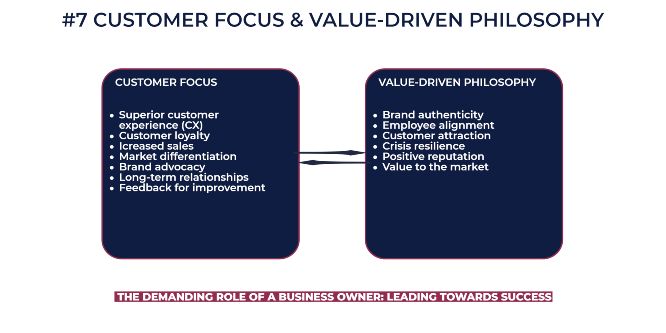
#7 Customer Focus and Value-Driven Philosophy
With a customer-centric approach, we focus on the end consumer and the market. We devote time and resources to research the market, the competition, and our business itself. We perform tests, collect feedback, and start discussing with the market and potential customers in real-time.
Developing products and services that solve current problems in the market is key because you can attract the right-fit customers easier and faster as you’re building trust in the first place when you perform research and start interacting with people.
It also helps in building long-term relationships with customers. And it results in superior customer experience (CX).
A value-driven philosophy is one of the biggest competitive advantages and business leaders know that first hand.
Being value-driven means that you respect and count all the interactions, transactions, and touchpoints with everyone – strangers, prospects, customers, fans, employees, suppliers, vendors, partners, other business owners, communities, and society at large.
Business leaders impact and improve people’s lives with their products/services, and generally, with their presence. It’s all about adding value, helping, caring, and listening.
Benefits of Being Customer-Centric
Customer Loyalty: Prioritizing customer needs and providing exceptional experiences fosters loyalty, repeat business, and positive word-of-mouth referrals.
Increased Sales: Satisfied customers are more likely to make additional purchases and explore upsell or cross-sell opportunities.
Market Differentiation: A customer-centric approach sets your business apart from competitors, attracting customers who value personalized service.
Brand Advocacy: Happy customers become brand advocates, promoting your products or services to their networks.
Long-Term Relationships: Building strong customer relationships leads to long-term partnerships, reducing the need for constant customer acquisition.
Feedback for Improvement: Engaging with customers provides valuable insights for product enhancement and business growth.
Benefits of a Value-Driven Philosophy
Brand Authenticity: Providing value at every touchpoint creates an authentic brand identity that resonates with customers and fosters trust.
Employee Alignment: Shared values unite employees, boosting morale, motivation, and collaboration.
Customer Attraction: Consumers are drawn to brands that reflect their own values, leading to increased customer engagement.
Crisis Resilience: A strong value-driven philosophy guides decision-making during challenges, maintaining consistency and trust.
Positive Reputation: Businesses with a clear value-driven approach are viewed positively by customers, partners, and stakeholders.
Value to the Market: Brands that provide value are helpful, guiding, sharing, solving people’s problems and challenges, educating and entertaining them, relieving their pain, covering their needs, wants, desires, and aspirations, and adding quality to their lives.
The list of benefits in this section is a dynamite. My methodology is exactly that… customer-centric, value-driven, and ethical.
Customer focus starts with understanding consumer behaviour.
I published a blog post analysing the topic in detail – it’s entitled “Consumer Behaviour: An Intro to Unveiling its Dynamics”.
What’s included:
- Overview
- Definition
- The study of consumer behaviour
- Questions of the study of consumer behaviour
- Factors that contributed to the development of the study of consumer behaviour
- Consumer behaviour is interdisciplinary
- Infographic #1
- The study of consumer behaviour is absolutely essential
- Consumer behaviour and the consumer
- Consumer behaviour and marketing strategy
- Consumer behaviour and public policy
- A simple model of consumer behaviour
- Infographic #2
- Resume
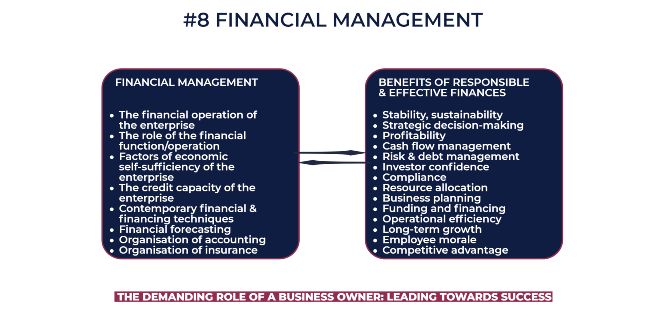
#8 Financial Management
The Financial Operation of the Enterprise
The development of business activity by a contemporary enterprise requires a significant number of material assets, such as fixed and circulating assets, but also intangible elements, such as know-how, patents and trademarks.
All these assets, which appear in the assets of the balance sheet of the enterprise, must be acquired. The capital required for this purpose can come from various sources – primarily from shareholders and lenders, and possibly from the state budget or various international or non-international institutions and organizations.
The Role of the Financial Function/Operation
Power Generation
The financial function is that which deals with the exploration of capital (own and foreign) for the business and with their disposal. That is, it is the operation that creates (produces) power for the establishment, operation, maintenance, development and expansion of the business.
The formation of the company’s capital (with its own or third parties), its work cycle, the creation and disposal of its profit and finally, the real value of the company depends on this operation.
In the framework of this operation, apart from the organization of capitalization, the business’s plans – budgets are drawn up, its economic and credit policy is defined, its cash organization is made, the financial results that occur from its activities are calculated and the claims/requirements are monitored as well as the company’s obligations.
The Capital of the Enterprise
The capital is connected to the property of the enterprise since it (in a broad sense, which identifies it with the liabilities of the enterprise) is the expression in money of the property of the enterprise (assets) and vice versa, the property or assets are the totality of goods, in which the capital of the business is invested and thus the equality arises, asset or property = liability, i.e. its sources of origin.
The Business Work Cycle
The formation of the company’s work cycle largely depends on the financial operation.
The business cycle is a transactional and accounting concept.
As a transactional concept, it corresponds, quantitatively, to the volume of sales made by a business within a certain period of time and based on value, to the receipts made from these sales and resulting from the calculation of the goods sold at their sales prices .
In accounting terms, the work cycle is distinguished into gross and net. The gross result is if any subsidies or premiums (e.g. export) are added to the nominal value of the invoices of a certain period. The net figure is obtained if, firstly, returns, offsets, discounts, value added tax, commissions and insurance policies are subtracted from the gross figure, and secondly if the internal invoicing (e.g. for subsidiaries) is added to the remainder businesses).
The Profit of the Enterprise
An important role of the financial function is to seek the profit of the business (and according to many the maximum possible) and to measure it.
Profit for the business is any positive change in the total value of its property (if it is realized with conditions of monetary stability), which is calculated between two points in time.
In order for the calculation of the company’s profit to be correct, two assumptions are made:
- the determination of the cost of the business must be accurate, and
- that the valuation of its assets is correct.
The company’s profit is divided into gross and net.
Real Value of the Enterprise
The real value of the business is the sum of its (real) intrinsic value and its surplus value. The surplus value is the real added value, created by certain assets or intangible assets, which the business has at a given time.
The surplus value of the business is a variable concept because what today offers surplus value to the business (eg customers) may not exist tomorrow.
Factors of Economic Self-Sufficiency of the Enterprise
Liquidity
Liquidity, in an absolute sense, is the immediate ability of the business to meet its financial obligations. More simply, it is the ability of the business to pay its obligations when they are due and in the amount they are due.
The lack of liquidity leads the business, either to inability to pay or to a forced divestment of assets.
The existence of liquidity in the enterprise is of great importance, because it shows financial power and self-reliance and contributes to the creation of a good reputation for its behaviour towards its creditors – which also expands its credit capacity.
Cash Flow
It is the difference that results from the introduction of capital into the business, and from the export of capital from the business.
During its life, but also between each use, the business realizes organic and inorganic income (from its main activity and from other ancillary activities), as well as organic and regular expenses or, abnormal and inorganic expenses and, the entire the procedure has an effect on the liquid assets of the enterprise.
This effect is positive (when it occurs for income) and negative (for expenditure).
Thus, at the end of each period there is an increase or decrease in the company’s liquidity and this difference constitutes its residual net cash flow.
It is clear that the increase in the company’s cash flow strengthens its financial position.
The Reserves
These are created by withholding part of the net profits of the business, when, at the end of the year, there are profits. They have the following characteristics:
- constitute profit that is not distributed
- constitute an increase in corporate property, and
- they are not incorporated into the corporate capital, nor do they increase the company’s obligations to third parties.
The purpose of the creation of reserves is to increase the means of the business and to deal with potential losses or deterioration of assets.
Internal Financing and Self-Financing
A business that operates (has a previous life, with profit, reserves, depreciation, loyalty/authority to the market, etc.) if it needs new capital for the continuation and more, for the development and expansion of its activity, it can follow two paths:
- internal financing (own capital) and
- external financing (foreign capital).
Internal financing has the following special forms:
- the increase of the company’s share (equity) capital with new payments from the same shareholders
- the use of capital collected from depreciation
- the use of capital derived from the sale of fixed assets
- the use of capital collected from temporary tax reliefs, given by the state for the relief, for a period of time, of the business, and
- the use of the part of the reserves allowed by the written provisions.
This last form of internal financing of the enterprise is called its “genuine self-financing” and it is the use of capitals created by withholding part of the profits of previous uses and forming reserves with them.
Depreciation
Depreciation in the context of business activity has a double meaning, economic and accounting.
In the economic sense, it means the gradual accumulation of amounts, which are calculated in the expenses (cost) of the business, which is carried out in compensation for the gradual depreciation (decrease in value) of the fixed assets of the business (caused by time and their operation ) so that there is a possibility of replacing them, when this is deemed necessary.
In the accounting sense, depreciation is, on the one hand, the systematic distribution of the value of the company’s fixed assets in the years of their estimated useful life, and on the other, the appearance with accounting entries of the gradual reduction in the value of these elements, the which is due to their normal wear and tear, from time and their operation.
Depreciation has three meanings for the business:
- accounting
- fiscal
- costing
The Working Capitals
Scientifically, working capital corresponds to equalities = (equity of the enterprise + plus long-term and medium-term receivables) – minus net fixed assets or liquid and available assets – minus short-term receivables.
In practice, entrepreneurs consider as working capital that which is necessary to meet the current needs of the business, in contrast to duration/permanent capital, which serves its permanent needs.
Businesses must foresee in their budget the allocation of capital, both for fixed assets (duration/permanent capital) and for working capital.
The existence of the necessary working capital strengthens the operational situation and the competitive position of the business and boosts its economic self-reliance.
The Credit Capacity of the Enterprise
Credit Area
It is the creditworthiness of the business, i.e. the ability to get credit, based on the trust it provides, which is created by objective and subjective factors.
Objective factors are:
- its asset and capital composition and its net worth or position
- the liquidity that appears
- the stability of its operations, in terms of the production and disposal of the products produced by it
Subjective factors are:
- the solvency of the enterprise
- the ability of the persons managing the business
- the adherence of these persons to the purposes of the enterprise and the exclusion of any channeling of credits provided to the enterprise, to other directions outside it.
Credits – Loans
Credit in general is the transfer of movable things from one economy (individual, business, social, public) to another economy, with the certainty, based on trust, that there will be both the will and the ability to return them, with the agreed terms.
Businesses, in their efforts to find foreign capital, turn to borrowing, i.e. taking out financial credits. Loans (credits) are drawn from the capital market, in the case of long-term capital, and from the money market, in the case of short-term capital.
The Capital Market
It is the purchase (offer – demand) of long-term capital. In this market, the demand for such capital comes from two sides, from businesses and from governments (directly or indirectly).
Businesses, mainly industrial ones, need long-term capital, for investments, both during their establishment and during the duration of their activity, for their renewal, expansion and modernization.
The methods by which these capitals are procured are two:
- long-term borrowing from credit institutions or special organizations, and
- the issuance of securities by these companies (bonds or shares), which are made available to savers and depositors, through the Stock Exchanges.
The Money Market
It is the purchase (offer – demand) of short-term capital. Such capital is requested by businesses to address immediate operational needs, or for working capital.
Providers of the short-term capital offer are:
- commercial banks (direct and main)
- private savers (indirectly)
Bank Grants/Financing
They are the most common form of lending (crediting) to businesses and constitute the main active function of banks, the active part of the money trading practiced by banks, from which their main income comes.
However, a prerequisite for the possibility of bank loans is the accumulation of own and much more foreign capital from deposits (which constitute the main passive function of banks).
All types of bank loans are associated with various risks which banking institutions try to anticipate and which they face when they appear. For this reason, certain factors have been established that are taken into account and concern, on the one hand, the banking institutions that make the grants and on the other, the businesses that receive them – which, however, I will not mention here.
The factors, moreover, that are taken into account by lending banks for the financing of businesses are:
- the sector and branch of production to which the enterprise belongs
- the type of raw materials and manufactured products used and the necessary stocks to maintain
- the needs of each business both for investments and for working capital
- the financial situation and the credit surface of the enterprise
- the financial program of the enterprise, short and medium term
- the position, status, ability and politics of those who run the business
- the behavior of the business in terms of its obligations to third parties, throughout its life
- the capabilities and potential of the business
The Fund Organization
This includes two sections, current receipts and current payments.
Τhe company’s current receipts result from:
- from sales of products and by-products “in cash”
- from sales of products and by-products “on credit”
- from discounts on letters of credit (bills of exchange and promissory notes)
- from advances against shipping documents
- obtaining bank loans by pledging goods and securities
- from internal and external credit openings
- from current bank accounts
- from sales of fixed assets
- from granting the right to use a model or a production method (royalty)
- from various other sources (e.g. rents)
The company’s current payments are:
- the costs of procurement of raw materials and any kind of auxiliary materials
- production costs
- sales promotion costs
- administration costs
- research costs
- the costs for servicing loans
- the expenses for payment of taxes
- the expenses for purchasing royalties
Business Investments
Business investment is the conversion of financial capital into business assets (fixed – mainly – and current assets – materials and tangible goods). The investment can have both material and immaterial objectives – intangible goods (rights, organization, etc.) and the human factor (purely productive investment).
Every investment goes through two stages – the study and decision on the one hand and the execution on the other – which include various partial phases, the totality of which constitutes the investment process.
Contemporary methods of calculating the economics of investments concern the application of Business Research (and especially linear programming and game theory) in combination with the use of computers, in order to deal with the conditions of uncertainty that usually exist.
I analyse Business Research in the 7 IDEALS Blueprint.
Contemporary Financial & Financing (Funding) Techniques
The most important of these are:
- financial lease – leasing
- factoring
- franchising
- forfaiting
- commercial bonds
- bank acceptance cheques
- certificates of deposit
- repurchase agreements
- government bonds
- the technique of the capital project evaluation
- the cash flow control technique
- the technique of consequences analysis
- the technique of cost-effectiveness analysis
- the technique of credit control
- the portfolio selection technique
- the technique of profit improvement
- the technique of profit planning
- the technique of profit sharing (distribution of profits)
- the technique of stock and share valuation
- the technique of high risk capital management – venture capital
- the technique of disposible liquid funds/assets
Financial Forecasting
Financial forecasting involves estimating future financial outcomes based on historical data, current market conditions, and various assumptions. It helps businesses plan and make informed decisions. Key components of financial forecasting include:
Revenue Projections: Estimating future sales and revenue based on historical performance, market trends, and sales pipeline data.
Expense Forecasting: Predicting operating expenses, including fixed and variable costs such as salaries, rent, utilities, and raw materials.
Cash Flow Forecasting: Anticipating the inflow and outflow of cash to ensure sufficient liquidity for day-to-day operations and investments.
Profit and Loss Projection: Projecting the company’s expected income and expenses over a specific period to calculate net profit or loss.
Balance Sheet Projection: Estimating the company’s assets, liabilities, and shareholders’ equity to assess financial health and stability.
Capital Expenditures: Forecasting investments in capital assets like machinery, equipment, and infrastructure.
Debt and Financing: Planning for debt repayments, interest payments, and new financing arrangements.
Taxes: Projecting tax liabilities and planning for tax payments based on applicable regulations.
Working Capital: Evaluating the availability of working capital to cover short-term operational needs.
Sensitivity Analysis: Assessing how changes in key assumptions (such as sales volume, pricing, and costs) impact financial outcomes.
Scenario Planning: Creating multiple scenarios based on different assumptions to understand potential outcomes under various circumstances.
Growth and Expansion Plans: Integrating projections related to new product launches, market expansions, or acquisitions.
Risk Assessment: Identifying potential risks and uncertainties that could impact financial forecasts and planning for mitigation.
Financial forecasting can help businesses make informed decisions, secure financing, allocate resources effectively, and adapt to changing market conditions. It’s a valuable tool for strategic planning and ensuring the financial sustainability of a business.
The Organisation of the Accounting Function/Operation
With the term Accounting we mean, first of all, the scientific and technical (scientific technique) which, in the framework of the more general Business Accounting, deals with the registration, classification and correlation, in value, of all economic transactions that contribute to the change of assets of the enterprise and give the image of the size and structure of the property, the capitals, the circulation of the assets and the results of the business activity and secondly, the business operation, which takes the name of a sector (directorate, services, department, or simply Accounting), which has as its object the recording and interpretation of every financial act of the enterprise. Accounting in the second sense is based on the first and applies in practice, in each economic unit, what the first teaches and offers for application.
Accounting as a scientific technique supports business accounting:
- to determine the grouping of the company’s assets and capital into categories of similar content
- monitoring the relationships and changes caused by the circulation of various assets
- in the calculation of the results (profits or losses) created by the business activity
The Organisation of Insurance Operations
The purpose of organizing insurance is to protect against any risk and to deal with any risk that may appear and threaten either the business as a whole, or its social organization (the human factor, the employees in the business), or the material of the organization (all its material elements, facilities, machines, raw materials, processed materials, products, goods, furniture, documents, forms, etc.), or its intangible assets (rights, organization, reputation, patents, and many others).
In the framework of the organization of insurance within the enterprise, the taking of preventive and repressive measures for each risk, the social insurance of the employees, the insurance of the assets of the enterprise and the securing of the rights of the enterprise are included.
First of all, the staff is systematically enlightened about the risks that may appear for themselves and for the environment in which they work and for the means they use.
For the compliance of the personnel with the relevant directives aimed at their protection, special surveillance instruments are used, which control their movements and behavior, from the point of view of the risks.
The most common risks are:
- Fires
- Thefts
- Decline, degeneration
- Accidents and injuries
- Events in the external environment
The Benefits of Responsible and Effective Financial Management
Responsible and effective financial management is crucial for the success and sustainability of any business. Here are some key benefits:
Stability and Sustainability: Proper financial management helps businesses maintain stability, especially during economic downturns or unexpected events. It ensures the availability of funds to cover operational expenses and financial obligations.
Strategic Decision-Making: Accurate financial information enables informed decision-making. Business leaders can evaluate different options, allocate resources wisely, and pursue growth opportunities while considering the financial implications.
Profitability: Effective financial management helps optimize revenue and control costs, leading to improved profitability. Monitoring financial metrics helps identify areas for improvement and implement strategies to increase profitability.
Cash Flow Management: Managing cash flow ensures that a business has sufficient liquidity to meet its day-to-day operational needs, pay suppliers, cover expenses, and invest in growth initiatives.
Risk Management: Financial management involves assessing and mitigating financial risks. Businesses can identify potential threats and develop strategies to minimize their impact.
Investor Confidence: Transparent and well-managed finances enhance investor confidence. Potential investors and stakeholders are more likely to support a business with a track record of responsible financial practices.
Debt Management: Effective financial management helps in managing debt obligations, making timely debt payments, and avoiding default situations that could negatively impact the company’s credit rating.
Compliance: Proper financial management ensures adherence to regulatory requirements and tax obligations. Avoiding non-compliance issues helps avoid penalties and legal troubles.
Resource Allocation: Financial management helps allocate resources efficiently by identifying areas where funds can be best utilized, optimizing return on investment.
Business Planning: Financial management is integral to creating comprehensive business plans. It provides the financial projections needed to set goals, allocate resources, and track progress over time.
Funding and Financing: Well-managed finances make a business more attractive to lenders and investors. It increases the likelihood of securing funding or financing for growth initiatives.
Operational Efficiency: Efficient financial processes streamline accounting, reporting, and budgeting tasks, reducing administrative burden and allowing more time for strategic activities.
Long-Term Growth: A solid financial foundation sets the stage for sustainable growth. With proper financial management, businesses can weather challenges and seize opportunities for expansion.
Employee Morale: Financial stability fosters a sense of security among employees, boosting morale and productivity. Employees are more likely to be motivated and committed when they see the company’s financial health.
Competitive Advantage: Effective financial management can provide a competitive advantage. Businesses that manage their finances well can respond quickly to market changes, make strategic investments, and innovate to stay ahead.
In summary, responsible and effective financial management is essential for a business’s overall health and success. It empowers businesses to make informed decisions, manage risks, seize opportunities, and achieve their long-term goals.
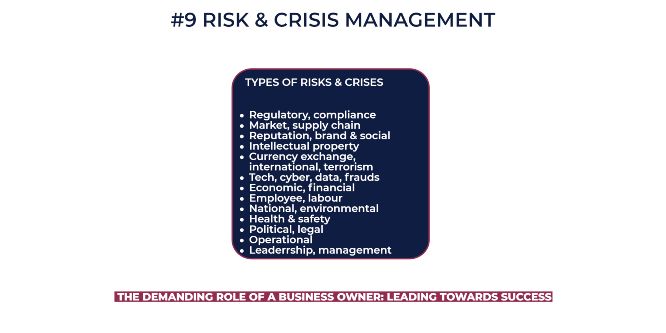
#9 Risk & Crisis Management
The world and our lives, in general, are changing at a rapid pace, affecting the context and environment of businesses. Businesses that want to stand out and pioneer will also have to constantly mutate.
However, few changes are truly autonomous, especially in businesses that are agents of continuous change in both economic and social relations, as well as the environment.
Many writers and economists recognize that the teleology of the business lies in its ability to survive by adapting to each situation and satisfying the needs generated by the restructuring and changes of the environment in which it evolves.
Under these conditions, one can easily conclude that the success of a business is closely linked to its ability to be an open system, easily adaptable to small or large upheavals and able to promote processes of change and self-regulation.
In this context, the necessity of managing the risks faced by businesses arises.
“Risk Management” is a theory of contemporary management, which began to be conceived as an idea and consolidated as a new philosophy at the end of the 1970s, during which the negative role of various dangerous events or even crises for the existence and the course of businesses had been clarified.
The modern philosophy of “Risk and Crisis Management” was developed with the aim of identifying, measuring and analyzing the risks and all kinds of crises that every modern business faces, as well as defining and consequently controlling any financial risk, which could be considered binding and dangerous for the viability and development of any business, while at the same organising the business by defining the plans and ways of dealing with and be protected by those risks and crises.
Types of Risks and Crises
Regulatory and Compliance Risks: Businesses need to ensure compliance with various laws and regulations specific to their industry. Failure to do so could result in legal penalties, fines, or even business shutdowns. Regulatory changes: Sudden changes in laws and regulations can impact business operations.
Supply Chain Risks: Disruptions in the supply chain, such as supplier bankruptcies, delays, or quality issues, can impact production and delivery schedules, leading to customer dissatisfaction. Supplier bankruptcy: Dependency on a single supplier could lead to production interruptions if that supplier goes out of business.
Inventory shortages: Delays or disruptions in the supply chain can result in inventory shortages.
Market Risks: Changes in consumer preferences, market trends, or competitive landscape can affect demand for products or services, potentially leading to decreased sales and revenue. Technological obsolescence: Failure to keep up with technological advancements could render products or services obsolete.
Reputation, Brand, and Social Risks: Negative publicity, customer complaints, or social media backlash can damage a brand’s reputation and erode customer trust. Social media backlash: Negative viral content on social media can damage a brand’s reputation. Product recalls: Defective products or safety concerns can damage a brand’s reputation and lead to legal issues.
Public Relations Crises: Scandals: Involvement in unethical or illegal activities can lead to public outrage and loss of trust. Negative media coverage: Media reports highlighting negative aspects of the business can harm reputation.
Intellectual Property Risks: Businesses need to protect their intellectual property (patents, trademarks, copyrights) from infringement or unauthorized use by competitors.
Currency Exchange and International Risks: If a business operates in multiple countries or deals with international transactions, it may be exposed to currency fluctuations, trade barriers, and geopolitical risks.
Technological Risks: Reliance on technology exposes businesses to risks such as system failures, data breaches, and cybersecurity threats that could lead to operational disruptions and reputational damage.
Cybersecurity and Data Risks & Crises: Data breaches: Unauthorized access to sensitive customer or business data can lead to financial losses and reputational damage. Ransomware attacks: Cybercriminals encrypt critical data and demand payment for its release, disrupting business operations.
Economic Risks: Inflation risk: Rapid inflation could erode purchasing power and increase operating costs. Economic downturn: A recession or economic slowdown can lead to reduced consumer spending and demand for products/services.
Financial Risks: Beyond economic risks, businesses face financial risks such as liquidity problems, interest rate fluctuations, credit risks, and unexpected changes in financial markets. Credit risk: Extending credit to customers who fail to pay can lead to bad debt and financial losses. Currency exchange risk: Fluctuations in exchange rates can affect the value of international transactions.
Financial Crises: Bankruptcy: Inability to meet financial obligations can lead to bankruptcy, affecting employees, investors, and creditors. Cash flow problems: Poor financial management can result in liquidity issues, affecting day-to-day operations.
Employee Turnover and Talent Risks: High employee turnover can disrupt operations and affect productivity. Businesses should have strategies to retain key talent and manage succession planning.
Employee-related Crises: Strikes and labor disputes: Work stoppages can impact production and relations with employees. Employee misconduct: Scandals involving employees can harm the company’s image.
Natural Disasters and Environmental Crises: Natural events such as earthquakes, floods, hurricanes, or wildfires can disrupt operations, damage assets, cause business interruptions, and lead to financial losses. Pollution and environmental violations: Mishandling waste disposal or violating environmental regulations can result in legal penalties.
Health and Safety Risks: Occupational health accidents and hazards: Exposure to hazardous substances or poor workplace conditions can harm employee health. Workplace harassment and discrimination: Failure to address these issues can lead to legal action and damage to the company’s reputation. Workplace accidents: Employee injuries can result in legal liabilities, medical costs, and decreased workforce productivity. Ensuring a safe working environment is critical to prevent accidents, injuries, and potential legal liabilities.
Health and Safety Crises: Health crises: Outbreaks of contagious diseases can impact employee health and business operations.
Political and Legal Risks: Changes in government policies, trade regulations, or political instability in a region can impact business operations, particularly for businesses with international exposure. Intellectual property infringement: Using or reproducing copyrighted material without proper authorization could lead to legal action. Non-compliance with data protection regulations: Failing to protect customer data as required by law can result in significant fines. Trade disputes: Trade restrictions and tariffs can disrupt supply chains and impact international operations.
Legal and Regulatory Crises: Lawsuits and legal challenges: Legal disputes with customers, competitors, or regulators can lead to financial losses. Regulatory violations: Non-compliance with regulations can result in fines and legal action.
Fraud and Corruption Risks: Internal and external fraud, bribery, and corruption can lead to financial losses and legal consequences. Internal fraud: Dishonest employees can misappropriate funds or manipulate financial records. Third-party corruption: Partnering with corrupt vendors or business partners can lead to legal and reputational risks.
Labour and Production Risks: Employee strikes or labour disputes: Work stoppages can disrupt production and damage relations with customers. Equipment breakdown: Unexpected breakdowns of essential machinery can lead to production delays.
Operational Risks: Business processes, technology failures, and human errors can result in operational disruptions, affecting efficiency and customer satisfaction.
Operational Crises: Supply chain disruptions: Problems with suppliers, transportation, or production can lead to shortages and delays. Equipment breakdown: Unexpected failures of essential machinery can halt production.
Disruption Risks: The rise of new technologies and business models can disrupt traditional industries, requiring businesses to adapt and innovate to stay relevant.
Leadership and Management Crises: Leadership changes: Sudden departures of key executives can disrupt operations and investor confidence. Management failures: Poor decision-making by leadership can lead to operational problems and financial losses.
Terrorism and Security Threats: Acts of terrorism: Security threats can affect employee safety and customer confidence. Cybersecurity threats: Attacks on digital infrastructure can compromise sensitive data and systems.
These are just a few examples of the numerous independent risks that businesses may encounter across different categories. A comprehensive risk management strategy should identify, assess, and mitigate these risks to ensure the business’s stability and success.
Benefits Of Dealing Effectively with Risks and Crises
Dealing with risks and crises effectively in the context of business is essential for a variety of reasons, and it offers several benefits. Here are some of the key advantages:
Preservation of Reputation: Effective risk and crisis management can help protect a company’s reputation. A well-handled crisis can actually enhance a company’s image if stakeholders see it as transparent, responsible, and responsive.
Minimized Financial Impact: Timely and effective risk management can prevent or mitigate financial losses. Businesses that are prepared for potential risks are more likely to recover quickly and with fewer financial repercussions.
Business Continuity: Managing risks and crises ensures business continuity. Companies that have comprehensive contingency plans in place are better equipped to maintain operations during and after a crisis, reducing downtime and revenue loss.
Competitive Advantage: Companies that demonstrate their ability to handle risks and crises effectively may gain a competitive advantage. Customers, partners, and investors often prefer to work with organizations that are reliable and resilient.
Compliance and Legal Protection: Effective risk management can help a company remain compliant with regulations and laws. It can also provide legal protection by demonstrating due diligence in preventing and addressing crises.
Employee Morale: Employees feel more secure and motivated when they know their company is prepared to handle risks and crises. A well-prepared workforce can be more productive during challenging times.
Stakeholder Trust: Building and maintaining trust with stakeholders, including customers, employees, investors, and suppliers, is crucial for long-term success. Effective risk management contributes to this trust.
Innovation and Growth: A company that effectively manages risks is more likely to be innovative and open to opportunities for growth. This is because it can take calculated risks and explore new markets or products with confidence.
Improved Decision-Making: Risk management encourages better decision-making by providing data and insights into potential threats and opportunities. This helps leaders make informed choices that align with the company’s strategic goals.
Insurance Cost Reduction: Companies that proactively manage risks may find that insurance premiums are more affordable, as insurers often reward organizations with strong risk management practices.
Sustainability: Addressing risks related to environmental, social, and governance (ESG) factors is increasingly important. Effective risk management can support a company’s sustainability efforts and reduce the risk of ESG-related crises.
Long-Term Viability: Ultimately, managing risks and crises effectively contributes to the long-term viability of a business. It helps ensure that the company can adapt and thrive in a rapidly changing business environment.
In summary, the benefits of dealing with risks and crises effectively in the context of business are far-reaching and impact various aspects of an organization’s performance, resilience, and reputation. It’s an integral part of strategic planning and management in today’s complex and uncertain business landscape.
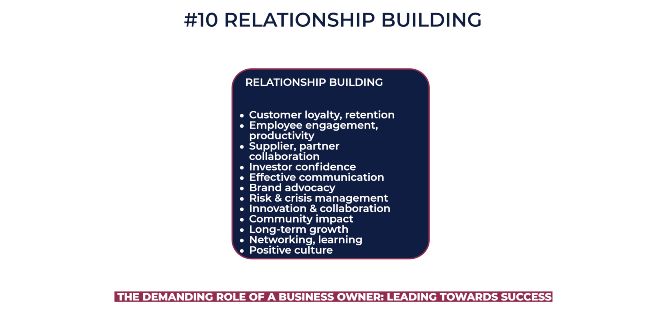
#10 Relationship Building
“Relationship building” for a business owner or leader involves fostering and maintaining positive connections with various stakeholders, including customers, employees, suppliers, partners, investors, and the community. It is about establishing genuine and meaningful relationships that go beyond transactional interactions.
The importance of relationship building for the business as a whole is immense and can have significant benefits:
Customer Loyalty and Retention: Building strong relationships with customers creates loyalty and repeat business. When customers feel valued and connected to the brand, they are more likely to continue purchasing products or services.
Employee Engagement and Productivity: A leader who invests in relationship building with employees creates a positive work environment. Engaged employees are more motivated, productive, and committed to their roles.
Supplier and Partner Collaboration: Cultivating relationships with suppliers and partners enhances collaboration and trust. This can lead to favourable terms, reliable deliveries, and innovative partnerships that benefit both parties.
Investor Confidence: Strong relationships with investors demonstrate effective leadership and transparency. Investors are more likely to support a company with a leader they trust and with whom they have a positive rapport.
Effective Communication: Open and honest communication is the foundation of good relationships. When leaders build relationships, they establish effective channels for communication, leading to better understanding and collaboration.
Brand Advocacy: Positive relationships with stakeholders can lead to brand advocacy. Satisfied customers, engaged employees, and supportive partners are more likely to promote the brand to others.
Risk & Crisis Management: During challenging times, strong relationships can provide a support network. Having a network of loyal stakeholders can be invaluable for navigating risks and crises and maintaining trust.
Innovation and Collaboration: Building relationships across industries and sectors can lead to new opportunities and innovation. Collaboration with external partners can result in creative solutions and expanded market reach.
Community Impact: Positive relationships with the local community and organizations contribute to the business’s social responsibility. This can enhance the brand’s reputation and make a positive impact.
Long-Term Growth: Relationships built on trust and mutual respect contribute to the long-term growth of the business. These relationships provide a foundation for sustainability and expansion.
Networking and Learning: Leaders who prioritize relationship building often have access to valuable networks and resources. They can learn from others, share insights, and stay informed about industry trends.
Positive Culture: Nurturing relationships fosters a positive organizational culture. A culture of trust, respect, and collaboration attracts and retains talent.
In essence, relationship building is about investing time and effort to create strong connections that benefit both the business and its stakeholders. A business owner or leader who prioritizes relationship building understands that success is not only measured by financial outcomes but also by the depth of the connections forged along the way.
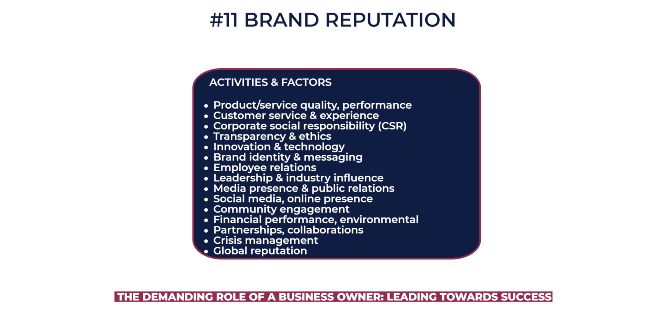
#11 Brand Reputation
Brand reputation is the perception and image that people hold about a company, and it’s influenced by a wide range of activities and factors. Here are the major categories of activities and factors that contribute to brand reputation:
Product/Service Quality and Performance:
The quality and performance of a company’s products or services play a significant role in shaping its reputation. Consistently delivering high-quality products can build trust and positive associations with the brand.
- Consistency and excellence in delivering high-quality products and services.
- Meeting or exceeding customer expectations.
- Ensuring reliability, durability, and performance.
Customer Service & Experience:
How a company treats its customers, handles complaints, and provides support can greatly impact its reputation. Exceptional customer service can lead to loyal customers and positive word-of-mouth.
- Providing exceptional customer service and support.
- Resolving customer issues promptly and effectively.
- Offering personalized experiences that cater to individual needs.
Corporate Social Responsibility (CSR):
Corporate social responsibility refers to a company’s efforts to contribute positively to society and the environment beyond its core business operations. This can include initiatives related to environmental sustainability, community engagement, ethical business practices, philanthropy, employee well-being, and more.
- Supporting social and environmental initiatives.
- Giving back to communities and making a positive impact.
- Ethical business practices and responsible sourcing.
Ethical business practices:
TRUE business leaders abide by ethical business practices. They are not fake, instead, they are authentic and transparent, behave morally, and follow the high standards of the business code of conduct.They do not deceive, defraud, cheat, or mistreat people, animals, and the environment – they respect everyone.
Benefits of ethical business practices:
- Trust and Reputation: Ethical behaviour builds trust with customers, suppliers, and the public, enhancing your reputation.
- Customer Loyalty: Ethical businesses attract socially conscious consumers who appreciate responsible practices.
- Legal Compliance: Ethical behaviour ensures compliance with laws and regulations, reducing legal risks.
- Employee Morale: Ethical practices create a positive work environment, boosting employee morale and job satisfaction.
- Partnership Opportunities: Ethical businesses are attractive partners for collaborations, joint ventures, and strategic alliances.
- Sustainability: Ethical practices contribute to environmental and social sustainability, aligning with changing consumer preferences.
CSR activities have a direct impact on a company’s brand reputation because they demonstrate the company’s commitment to making a positive difference in the world. When a company engages in meaningful CSR efforts, it can enhance its reputation and build stronger relationships with customers, employees, investors, and other stakeholders. Here’s how CSR contributes to brand reputation:
- Enhanced Image: Engaging in CSR activities showcases a company’s commitment to ethical and socially responsible practices, enhancing its image in the eyes of consumers and stakeholders.
- Trust and Credibility: Companies that prioritize CSR demonstrate transparency and authenticity, which builds trust and credibility with customers and the public.
- Differentiation: CSR efforts can differentiate a brand from competitors by showcasing unique values and contributions to society.
- Employee Engagement: CSR initiatives can boost employee morale, as employees feel proud to work for a company that makes a positive impact.
- Customer Loyalty: Consumers are more likely to support brands that align with their values and actively contribute to societal betterment.
- Investor Confidence: Investors often consider a company’s CSR efforts as an indicator of long-term sustainability and ethical governance.
- Media Coverage: Positive CSR initiatives attract media attention, leading to positive coverage that reinforces the company’s reputation.
- Partnerships and Collaboration: Companies engaged in CSR can attract like-minded partners, leading to collaborations that further strengthen their reputation.
It’s important to note that CSR efforts should be genuine and aligned with the company’s values and goals. Inauthentic or “greenwashing” attempts to appear socially responsible without meaningful actions can backfire and harm brand reputation. Therefore, integrating CSR as part of a comprehensive brand strategy is key to building a strong and positive brand reputation.
Transparency and Ethics:
- Open and honest communication with stakeholders.
- Adherence to ethical business practices.
- Avoidance of scandals or controversies.
Innovation and Technology:
Brands that are known for innovation and staying ahead of industry trends are often viewed favourably. Innovation can signify relevance and a commitment to meeting changing customer needs.
- Demonstrating innovation and adapting to industry trends.
- Developing cutting-edge products and services.
- Embracing technology to improve customer experiences.
Brand Identity and Messaging:
The way a brand presents itself through its visual identity, messaging, and positioning contributes to its reputation. Consistency and authenticity in brand communication are crucial.
- Consistency in brand visuals, logos, and messaging.
- Authenticity that resonates with the target audience.
- Clear and compelling brand story and positioning.
Employee Relations:
- Fostering a positive workplace culture.
- Treating employees with respect and providing growth opportunities.
- Employee satisfaction (happy and motivated employees can positively impact a company’s reputation. Employees who speak positively about their workplace can enhance the brand’s image), engagement, and advocacy.
Leadership and Industry Influence:
Brands that are perceived as leaders in their industry, whether through thought leadership, expertise, or market share, tend to have a strong reputation.
- Thought leadership and expertise in the industry.
- Demonstrating industry leadership and influence.
- Being recognized as an authority in the field.
Media Presence and Public Relations:
Positive coverage in media and press can bolster a brand’s reputation. Building relationships with media outlets can lead to favourable coverage.
- Positive coverage in media and press.
- Effective management of media relations and crisis communication.
- Strategic public relations campaigns.
Social Media and Online Presence:
Social media platforms provide an opportunity for brands to engage directly with their audience. Effective use of social media can influence reputation.
- Engaging with customers and stakeholders on social media.
- Building a strong online presence and fostering digital communities.
- Monitoring and responding to online conversations about the brand.
Community Engagement:
Beyond Corporate Social Responsibility (CSR), actively participating in local communities and supporting causes can contribute to a positive brand reputation.
- Engaging with local communities through partnerships and initiatives.
- Supporting local causes and contributing to societal well-being.
Transparency and Ethics:
Companies that demonstrate transparency in their operations and adhere to ethical business practices tend to have a stronger reputation. Honesty and integrity are highly valued by consumers.
Financial Performance:
- Demonstrating stability and strong financial performance.
- Responsible financial management and transparency.
Environmental Stewardship:
- Environmental sustainability efforts and initiatives.
- Reducing elements that hurt the environment and promoting eco-friendly practices.
Partnerships and Collaborations:
Partnerships with reputable organizations can reflect positively on a brand. Collaborations with respected brands can enhance credibility.
- Building strategic partnerships with respected organizations.
- Collaborations that align with the brand’s values and enhance credibility.
Crisis Management:
How a company handles crises and difficult situations can significantly impact its reputation. Effective crisis management and communication can mitigate damage.
- Effectively handling crises and unforeseen challenges.
- Minimizing negative impacts and maintaining trust during difficult times.
Global Reputation:
- Managing the brand’s reputation across different markets and cultures.
- Building a positive international image and adapting to local nuances.
Each of these categories contributes to shaping the overall reputation of a brand. Successful brands focus on cultivating a positive image through a combination of these factors and activities, and they consistently deliver on their promises to customers, employees, and stakeholders.
Overall, brand reputation is the result of a combination of actions, behaviours, and perceptions. It’s an ongoing effort that requires a holistic approach and alignment with the values and promises a brand makes to its stakeholders.
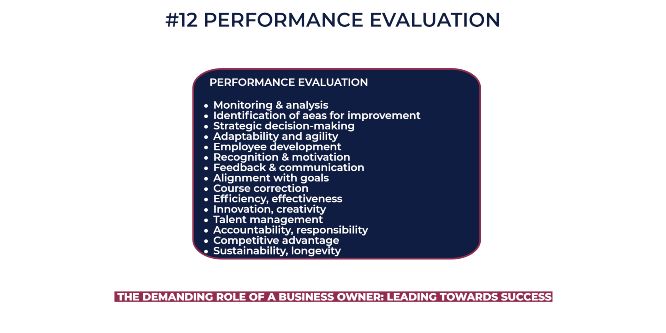
#12 Performance Evaluation
Performance evaluation is a critical aspect of effective leadership, and its significance for the overall success and growth of the business cannot be overstated.
Monitoring and Analysis: Business leaders regularly monitor the company’s performance against predefined metrics, KPIs, and strategic goals. This involves gathering and analyzing data to assess how well the business is meeting its objectives.
Identification of Areas for Improvement: Through performance evaluation, leaders identify areas of the business that require improvement or adjustment. This could involve identifying operational inefficiencies, underperforming departments, or deviations from the strategic plan.
Strategic Decision-Making: Performance evaluation provides leaders with insights to make informed decisions. It helps them allocate resources effectively, prioritize initiatives, and steer the business in the right direction.
Adaptability and Agility: Businesses operate in dynamic environments. Performance evaluation enables leaders to adapt quickly to changing circumstances, such as shifts in market trends, customer preferences, or economic conditions.
Employee Development: Leaders assess the performance of individual employees and teams. This allows them to provide constructive feedback, identify training needs, and support professional growth.
Recognition and Motivation: Top-performing executives and staff members are recognized and rewarded. This recognition not only motivates individuals but also sets an example for others to strive for excellence.
Feedback and Communication: Performance evaluations serve as a platform for open communication between leaders and employees. Constructive feedback fosters a culture of continuous improvement.
Significance of performance evaluation for the overall success and growth of the business:
Alignment with Goals: Regular performance evaluation ensures that the business remains aligned with its strategic goals. It enables leaders to confirm whether actions and decisions are contributing to the desired outcomes.
Course Correction: If the business is not performing as expected, performance evaluation enables leaders to identify the root causes and take corrective actions promptly. This prevents the business from straying off course.
Efficiency and Effectiveness: Evaluation helps leaders identify inefficiencies and areas where resources can be optimized. It ensures that resources are allocated where they can have the greatest impact.
Innovation and Creativity: By recognizing and rewarding innovation and creativity, leaders foster a culture of ingenuity. This drives the development of new products, services, and solutions.
Talent Management: Identifying and rewarding top performers helps retain valuable talent and attract skilled professionals who seek growth opportunities.
Motivation and Engagement: When employees see their contributions acknowledged, they are motivated to perform at their best. This leads to higher engagement levels and overall job satisfaction.
Accountability and Responsibility: Performance evaluation holds leaders accountable for their decisions and actions. It encourages responsible leadership and a commitment to achieving results.
Continuous Improvement: Performance evaluation is a mechanism for continuous improvement. It ensures that the business is always striving to do better and exceed expectations.
Competitive Advantage: Businesses that consistently evaluate their performance and make necessary adjustments gain a competitive advantage. They are more adaptable and responsive to market changes.
Sustainability and Longevity: A business that regularly evaluates its performance is better equipped to navigate challenges, capitalize on opportunities, and achieve long-term sustainability and growth.
In conclusion, performance evaluation is a cornerstone of effective leadership. It empowers business owners and leaders to make informed decisions, guide their teams, and ensure that the business remains on a path of success and growth. By fostering a culture of continuous improvement and recognizing top performers, leaders set the stage for lasting achievements.
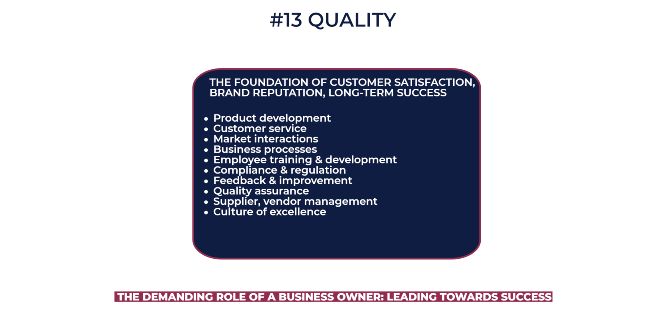
#13 Quality
Ensuring “quality” in all aspects of the business is a critical role of the business owner. Quality is the foundation of customer satisfaction, brand reputation, and long-term success. Here’s how the business owner ensures quality in various areas:
Product Development: The business owner plays a key role in setting quality standards for products and services. They focus on delivering value, functionality, and reliability to meet customer needs and expectations.
Customer Service: Providing exceptional customer service is vital for building loyalty and repeat business. The business owner instills a customer-centric approach, emphasizing responsiveness, empathy, and problem-solving to ensure positive customer experiences.
Market Interactions: The business owner oversees marketing communications and interactions with the market. They ensure that messaging is clear, honest, and aligns with the company’s values to build trust and credibility.
Business Processes: Quality extends to all internal processes. The business owner streamlines operations, implements quality control measures, and continuously seeks ways to improve efficiency and effectiveness.
Employee Training and Development: Investing in the training and development of employees ensures that they have the skills and knowledge needed to deliver quality products and services.
Compliance and Regulation: The business owner ensures compliance with relevant laws, regulations, and industry standards to maintain ethical practices and avoid legal issues.
Feedback and Improvement: Encouraging and acting upon customer feedback and suggestions is crucial for continuous improvement. The business owner actively seeks feedback and uses it to enhance products, services, and overall customer experience.
Quality Assurance: Implementing quality assurance processes helps identify and rectify issues before they impact customers. The business owner prioritizes quality assurance to deliver consistent and reliable results.
Supplier and Vendor Management: Selecting reputable suppliers and vendors ensures that the business receives quality materials and services, contributing to the overall quality of the end product.
Culture of Excellence: The business owner fosters a culture of excellence and continuous improvement. Recognizing and rewarding employees for their commitment to quality reinforces the importance of delivering high-quality outcomes.
By focusing on quality across all aspects of the business, the owner ensures that the company earns the trust and loyalty of customers, strengthens its competitive advantage, and maintains a positive reputation in the market. Ultimately, a commitment to quality helps the business thrive and grow in the long run.
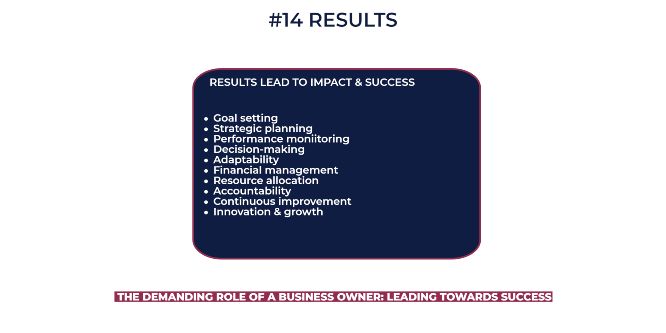
#14 Results
Referring to the business owner’s role in bringing “results” from every activity and initiative is crucial to highlighting their impact on the success of the business. Here’s how the business owner ensures results in various aspects of the business:
Goal Setting: The business owner sets clear, measurable, and achievable goals for the company. These goals provide a roadmap for success and serve as benchmarks to track progress and results.
Strategic Planning: The business owner develops and executes strategic plans to steer the business in the right direction. Strategic planning ensures that resources are allocated effectively to achieve desired outcomes.
Performance Monitoring: The business owner closely monitors the performance of the business, departments, and employees. They use key performance indicators (KPIs) to assess progress and identify areas for improvement.
Decision Making: Making informed and data-driven decisions is a key responsibility of the business owner. They analyze data, market trends, and customer feedback to make decisions that lead to favourable outcomes.
Adaptability: The business owner stays adaptable and responsive to changes in the market and business environment. They embrace innovation and new opportunities while mitigating risks.
Financial Management: The owner oversees financial matters to ensure the business remains profitable and sustainable. They control costs, manage budgets, and seek ways to optimize financial performance.
Resource Allocation: Allocating resources effectively to projects and initiatives that align with the company’s goals and priorities is a critical role of the business owner.
Accountability: The owner holds themselves and their team accountable for delivering results. They foster a culture of responsibility and ownership throughout the organization.
Continuous Improvement: The business owner encourages a culture of continuous improvement. They learn from both successes and setbacks, implementing changes to enhance results.
Innovation and Growth: The owner drives innovation and seeks opportunities for growth. They identify new markets, products, and strategies that lead to business expansion and increased profitability.
By emphasizing in achieving results, a business owner/leader highlights their hands-on approach to steering the business towards success. This focus on results underscores the owner’s commitment to the company’s vision and mission and their dedication to delivering value to customers, employees, and stakeholders.
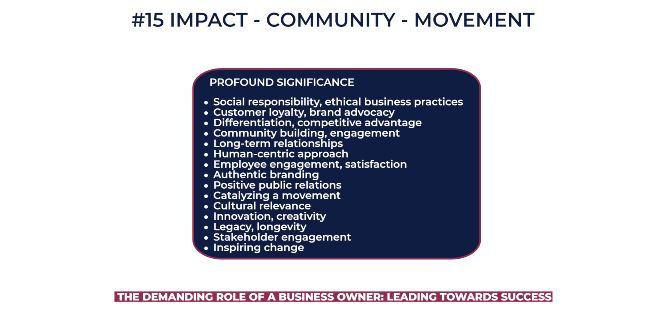
#15 Impact – Community – Movement
The concept of creating impact, fostering community, and sparking a movement within a business has profound significance for its success and growth.
Social Responsibility and Ethical Business Practices: Businesses that focus on making a positive impact on society and the environment demonstrate a commitment to social responsibility. This resonates with conscious consumers and builds a positive reputation for the brand.
Customer Loyalty and Brand Advocacy: When businesses contribute to causes that customers care about, they foster a sense of loyalty and emotional connection. Satisfied customers become brand advocates, spreading the word and generating positive word-of-mouth.
Differentiation and Competitive Advantage: Businesses that go beyond profit maximization stand out in a crowded market. They differentiate themselves by aligning with values that resonate with their target audience.
Community Building and Engagement: Creating a sense of community around a brand fosters a loyal customer base. This engagement goes beyond transactions, as customers feel part of a larger movement with shared values.
Long-Term Relationships: Businesses that focus on community-building aim for long-term relationships with customers. This approach leads to repeat business, referrals, and sustained growth.
Human-Centric Approach: Prioritizing impact and community reflects a human-centric approach to business. This builds trust and credibility, as customers see the brand as more than a profit-driven entity.
Employee Engagement and Satisfaction: Employees are motivated to work for companies that contribute positively to society. Engaged and proud employees contribute to the success of the business.
Authentic Branding: An authentic commitment to impact and community resonates with consumers who seek brands that align with their values. Authenticity builds brand trust.
Positive Public Relations: Businesses that engage in community initiatives and causes attract positive media attention. This enhances brand visibility and reputation.
Catalyzing a Movement: Transitioning from building communities to sparking movements elevates the brand beyond a transactional relationship. Customers become advocates and participants in a larger cause.
Cultural Relevance: Businesses that are part of movements tap into cultural relevance and societal shifts. This keeps the brand current and resonant with evolving consumer attitudes.
Innovation and Creativity: Movements often push businesses to innovate and think creatively. Finding novel ways to contribute to a cause can lead to unique products, services, and marketing campaigns.
Legacy and Longevity: Businesses that leave a positive impact on communities and society create a lasting legacy. This legacy contributes to the business’s longevity and continued relevance.
Stakeholder Engagement: Beyond customers, impact and movement-based initiatives engage stakeholders such as employees, partners, investors, and regulators.
Inspiring Change: Businesses that drive movements inspire change on a larger scale. This can influence consumer behaviour, industry norms, and societal practices.
In conclusion, the “Impact, Community, Movement” approach transforms businesses into catalysts for positive change. By focusing on creating a meaningful impact, fostering communities, and sparking movements, businesses not only succeed financially but also contribute to a better world. This approach resonates deeply with consumers, employees, and stakeholders, leading to sustained growth and enduring success.
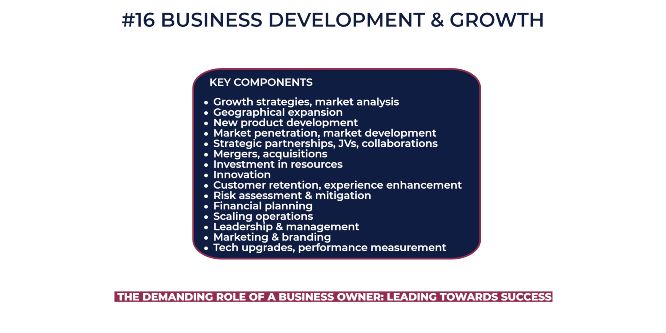
#16 Business Development and Growth
This aspect of business management is crucial for expanding the reach, impact, and success of a company.
Key Components of Business Development and Growth:
Growth Strategies: Developing and implementing strategies to achieve growth objectives. This could involve market penetration, market expansion, product development, diversification, strategic partnerships, acquisitions, and more.
Market Analysis: Thoroughly researching and analyzing market trends, customer preferences, competitive landscape, and emerging opportunities to identify areas for growth.
Geographical Expansion: Exploring new markets, regions, or territories to expand the business’s reach and tap into previously untapped customer bases.
New Product Development: Creating and launching new products or services that cater to existing or new customer needs, thereby expanding the product line.
Market Penetration: Increasing market share within the existing market by capturing a larger portion of the target audience.
Market Development: Expanding the business’s customer base by entering new market segments or demographics.
Strategic Partnerships: Collaborating with other businesses to leverage each other’s strengths and resources, opening new opportunities for growth.
Joint Ventures and Collaborations: Forming strategic partnerships with other companies to jointly develop and market new products or services.
Mergers and Acquisitions: Acquiring or merging with other businesses to consolidate market share, access new markets, or gain synergies.
Investment in Resources: Allocating resources, such as capital, manpower, technology, and infrastructure, to support expansion efforts.
Innovation: Fostering a culture of innovation to continuously develop new offerings that meet evolving customer needs.
Customer Retention: Implementing strategies to retain existing customers and maximize their lifetime value to the business.
Risk Assessment and Mitigation: Identifying potential risks and challenges associated with growth strategies and devising plans to mitigate them.
Financial Planning: Creating financial models and projections to ensure that growth initiatives are financially sustainable.
Scaling Operations: Ensuring that the business’s operational capacity can handle increased demand resulting from growth initiatives.
Leadership and Management: Developing leadership and management structures to oversee larger teams and more complex operations.
Cultural Alignment: Ensuring that the company’s culture and values remain intact and aligned with growth efforts.
Marketing and Branding: Adapting marketing and branding strategies to appeal to new markets and audiences.
Technological Upgrades: Incorporating technology advancements to enhance operational efficiency, customer experience, and innovation.
Performance Measurement: Establishing key performance indicators (KPIs) to track and measure the success of growth initiatives.
Customer Experience Enhancement: Ensuring that the quality of products, services, and customer interactions is maintained or improved during expansion.
In conclusion, “Business Development and Growth” involves strategic planning, innovation, risk assessment, resource allocation, and collaboration to expand a business’s reach, revenue, and impact. It requires a holistic approach that spans various departments and functions, all guided by a clear vision for the company’s future.
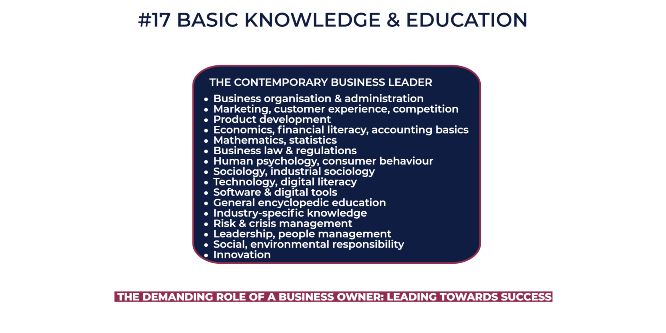
#17 Basic Knowledge and Education
The business owner’s education and knowledge base is crucial to understanding their expertise and ability to make informed decisions.
This is the contemporary business leader’s education list:
Business Organisation: This includes:
organizational structure and organization, management based on objectives, authorization, development of the organizational structure, organization charts, job description, segmentation or grouping of projects: segmentation by functions, by departments, organizational behaviour, human behaviour in organizations, the effect of motivation and ability on the behaviour of individuals within the organization, the effect of management philosophy on the behaviour of individuals within the organization, effect of organizational institutions on the behaviour of individuals within the organization, personal and organizational communication, organisational change (management, tactics of reducing reactions, the Greiner Model), and more
Business Management/Administration: programming, planning, organising, managing, coordinating, monitoring, controlling, staffing, motivating, rewarding, being creative, innovative, MIS, modern systems of management practice: MBO, MBR, MBS, MFR, MBE, MBP, MBBC, MBBR, and more
Marketing: it includes market research, branding, advertising, sales, negotiation skills, customer service, organising events, and more. A successful business owner should possess strong sales and negotiation skills. This includes understanding customer needs, effective communication, and building strong relationships.
Product Development: a business leader should oversee product development in cooperation with the production manager to ensure efficiency, customer satisfaction and retention, and competitive advantages.
Economics: the business leader should have at least a basic understanding of economics to forecast, navigate, and surpass economic fluctuations, recession periods, and changing international standards.
Financial Literacy: In addition to basic financial knowledge, the business owner should understand financial statements, cash flow management, and financial planning.
Accounting: Business leaders should also have a robust knowledge of things such as cash flow, profits and losses, taxes, and more.
Mathematics: Lacking a foundation in business math, numerous business choices would be formulated devoid of a genuine grasp of the underlying figures or the possible ramifications of pivotal decisions. Mathematical applications find their significance in various facets of business. In a broader sense, proficiency in business math empowers individuals and enterprises to enhance decision-making, delve into predicaments with greater depth, and discern the enduring repercussions of their chosen courses of action.
Statistics: Business statistics furnishes managers with data, enabling them to formulate effective decisions rooted in foundational principles rather than relying solely on intuition. The utilization of statistics involves dissecting data and deriving insights, be it for projecting sales, launching novel product lines, devising innovative production strategies, and more.
Business Law and Regulations: Comprehending the significance of business law for your enterprise is imperative due to several compelling factors. This knowledge empowers you to navigate governmental regulations adeptly, minimizing the risk of legal disputes and establishing a robust groundwork. It aids in establishing an appropriate organizational structure, adhering diligently to governmental statutes, and addressing multifaceted aspects such as employee contracts, tax filings, and strategic marketing initiatives.
Human Psychology: The significance of psychology in business administration cannot be overstated. A profound comprehension of human psychology, whether concerning employees, customers, or business associates, plays a pivotal role in enhancing management practices and fostering business expansion. Every participant in the business ecosystem, spanning from shareholders and managers to governmental bodies and employees, constitutes individuals. Consequently, as human interactions are inherent, psychological dynamics come into play, exerting their influence across all dimensions of business. Psychology serves as a lens through which we unravel human behaviours and discern the rationale behind thoughts, methodologies, behaviours, and objectives.
Consumer Behaviour: a necessary key to developing a unique marketing strategy and getting people to respond positively to our communications.
Sociology and Industrial Sociology: The field of sociology provides valuable insights into the cultural and social factors that mold individual team members. Armed with this understanding, you can sidestep the inadvertent alienation of staff and safeguard company loyalty. Engaging with sociology fosters the honing of analytical thinking skills, enabling you to pinpoint market prospects, enhance public relations, and unlock a multitude of other benefits.
Technology and Digital Literacy: In today’s digital age, having knowledge of technology and digital tools is essential. The business owner should be familiar with relevant software, online platforms, and digital marketing strategies.
Computers: In the realm of business, computers have evolved into indispensable tools. Their utilization permeates every facet of a company’s functioning, spanning from product development and marketing to accounting and administrative tasks. The meticulous selection of appropriate computers, software, and peripherals holds paramount importance for business proprietors. Given the extensive array of contemporary technology, ranging from smartphones and tablets to expansive desktop systems, navigating the optimal technological landscape for your business can indeed be a formidable undertaking.
Software & Digital Tools: While your business aspirations may be lofty, the absence of suitable tools can inadvertently complicate matters. A leader shoulders a diverse array of tasks and responsibilities, where the incorporation of software can provide substantial aid across various realms of business operations.
General Encyclopedic Education: General encyclopedic education can be beneficial for a business leader, but its importance may vary based on the specific circumstances and context. Here are some considerations:
- Broad Knowledge Base: A business leader with a well-rounded education might have a broader understanding of various subjects, which could be useful when making informed decisions that impact different aspects of the business.
- Critical Thinking: An encyclopedic education can nurture critical thinking and problem-solving skills. This can be advantageous when dealing with complex challenges and making strategic decisions.
- Interdisciplinary Insights: Business leaders often need to collaborate with professionals from diverse fields. An encyclopedic education can facilitate effective communication and understanding across different disciplines.
- Creativity and Innovation: Exposure to various subjects can stimulate creative thinking and innovation, enabling leaders to approach problems from unconventional angles.
- Cultural Awareness: A broad education can enhance cultural awareness and sensitivity, which is crucial when dealing with a globalized business environment and diverse teams.
- Ethical Considerations: Knowledge of various disciplines can provide a more comprehensive understanding of ethical implications, aiding leaders in making morally sound decisions.
Industry-Specific Knowledge: The business owner should have a deep understanding of the industry in which their business operates. This includes staying up-to-date with industry trends, regulations, and best practices.
Risk Management: Understanding risk and how to mitigate it is vital for any business owner. This includes identifying potential risks, creating contingency plans, and ensuring compliance with relevant regulations.
Leadership and People Management: As a leader, the business owner should be skilled in motivating and managing teams, resolving conflicts, and fostering a positive work culture.
Customer Experience: Knowledge of customer behaviour, preferences, and satisfaction is essential for delivering an exceptional customer experience.
Competitive Analysis: The business owner should be able to conduct a competitive analysis to understand the strengths and weaknesses of competitors and position their business strategically.
Environmental and Social Responsibility: A responsible business owner considers the environmental and social impact of their operations. Knowledge of sustainability practices and social responsibility is important.
By highlighting the business owner’s diverse educational background and knowledge base, we emphasize their versatility and ability to handle multifaceted challenges in the business world. It demonstrates their commitment to continuous learning and growth, which is essential for driving success in the ever-evolving business landscape.
#18 The 7ID Amalgam
This is a concept that I will discuss during the 7 IDEALS presentation and it can make a huge difference for business owners and leaders. For me, it’s the most critical aspect of being a leader 🙂
Epilogue
In the dynamic landscape of business, the role of a business owner transcends the boundaries of traditional leadership. It’s a role that demands visionary thinking, adaptability, and a deep understanding of the intricate web that binds every facet of the company. The business owner is not merely an overseer but a driving force, a compass guiding the ship through uncharted waters.
From setting a clear vision that propels the company forward to making strategic decisions that define its trajectory, the business owner’s responsibilities are vast and varied. They are architects of growth, shaping not only their enterprise but also the communities they touch. It’s a journey that requires resilience, an unyielding commitment to excellence, and an insatiable thirst for knowledge.
Aspiring entrepreneurs, take heed. The path of entrepreneurship is a challenging one, marked by uncertainties and complexities. Yet, within these challenges lie opportunities for transformation, innovation, and profound impact. Embrace the unknown with open arms, for it is in navigating uncharted territories that true leaders emerge. Each decision, each step forward, is a testament to your dedication to not only your business but also the people it serves.
The role of a business owner is not confined to titles or tasks. It’s a calling, a vocation that demands continuous growth and learning. The journey is a relentless pursuit of knowledge, a constant endeavor to blend vision with strategy, innovation with tradition, and challenges with solutions. With each challenge overcome, a business owner’s influence grows, touching lives, shaping industries, and leaving a legacy.
So, to the budding entrepreneurs, embrace your role with open arms. Embrace the sleepless nights, the tough decisions, the exhilarating wins, and the humbling setbacks. For in each of these experiences, you are sculpting yourself into a leader. Let every obstacle fuel your determination, let every success ignite your passion, and let every setback fortify your resilience.
In the world of business, the role of a business owner is not just about profits and products; it’s about purpose and impact. It’s about creating a legacy that extends beyond balance sheets, one that resonates with the communities you touch and the lives you transform. So, take the reins, steer your course, and lead with unwavering conviction. Your journey is not just a business journey; it’s a journey of leadership, growth, and making a lasting mark on the world.

Tasos Perte Tzortzis
Business Organisation & Administration, Marketing Consultant, Creator of the "7 Ideals" Methodology
Although doing traditional business offline since 1992, I fell in love with online marketing in late 2014 and have helped hundreds of brands sell more of their products and services. Founder of WebMarketSupport, Muvimag, Summer Dream.
Reading, arts, science, chess, coffee, tea, swimming, Audi, and family comes first.





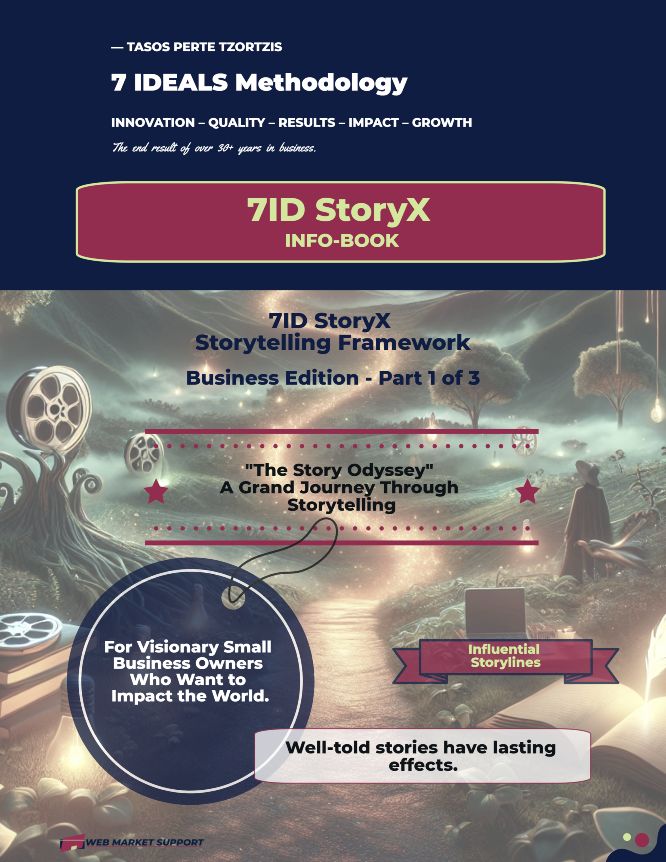






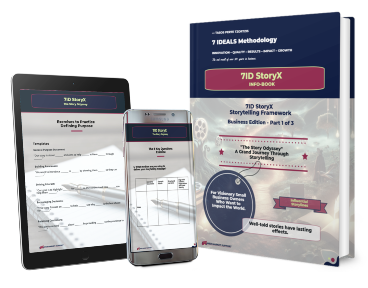
0 Comments